#scaryhistory
Explore tagged Tumblr posts
Text
Mystery and Missing: The Tragic Trails of the Bennington Triangle
Nestled into the southwestern region of Vermont lies an expanse of wilderness stretching approximately 100 square miles. Thick with forest and natural wonders including the Glastenbury Mountain this region, roughly bordered by the towns of Glastenbury, Woodford, and Bennington, has deep rooted history including the first town created in Vermont and significant chapters in the American Revolution. It is scenic, it is historic, and to many it’s also terrifying.
The chilling stories of Glastenbury Mountain began centuries ago when the Native American population regarded the space as sacred, but also cursed. Being the place “where the four winds meet” they used the area only for the burial of their dead and warned people not to travel the region. They also told the tale of a large and malicious stone that would swallow up anyone who stood on it. If a curse placed by nature, a revered-but-feared burial ground, and a rock that could consume a human was not enough, there were also the tales of the wild men, large hairy human-like creatures that roamed the dense woods alongside other beasts.

Postcard showing Glastenbury Mountain. Image via legendsofamerica.com.
These tales were known but in the decades after the Civil War the old warnings faded and people now living in the region looked to transform their town. In 1872 the town began its first metamorphosis, becoming a logging community fed by the ample and seemingly endless supply of lumber surrounding them. A train line was built extending nine miles to Bennington and three coal kilns supplied coal that would be shipped down the mountain on the rails. The operations were a success and by 1880 the little town had a school, post office, and a population of 241 people. It looked promising but in the 1890s a black cloud seemed to take a firm residency over the region.
The first strike came on April 4th 1892 when Glastenbury residents Henry McDowell and John Crowley had a confrontation. It is unknown what words were exchanged, but McDowell felt they were strong enough to warrant grabbing a rock and bludgeoning Crowley to death before escaping into the woods. He was eventually caught in Connecticut, convicted, and sent to Waterbury State Hospital. After some time though, the guards felt he could be trusted to spend some time out in the yard. Once outside he saw his moment and hid in a coal cart before making his escape. He was never seen again. Five years later in October 1897 John Harbour of nearby Woodford was found dead, killed by a single gunshot wound. His killer was never found.
It was in that same year that Glastenbury came face to face with a big problem. They were a lumber town, but they were running out of trees to cut. Given that they already had cleared land, created pathways, and had a number of silent buildings from the now-extinct lumber industry, they decided to take an entirely different turn and transform the area into a resort town with a trolley, hotel, and casino. The hopes were high, but after one season the dreams were decimated when massive flooding ravaged the town. With no trees or root systems to help alleviate the impact of the water, it ran over with nothing in its path, destroying the railways leading to the resort that was going to save the town. The flood was the death blow to Glastenbury and with seemingly no other option, the residents moved on leaving the town nearly abandoned with less than ten residents remaining. This low population was one of the reasons that in 1937 the town was disincorporated, putting it in place to officially become a ghost town.
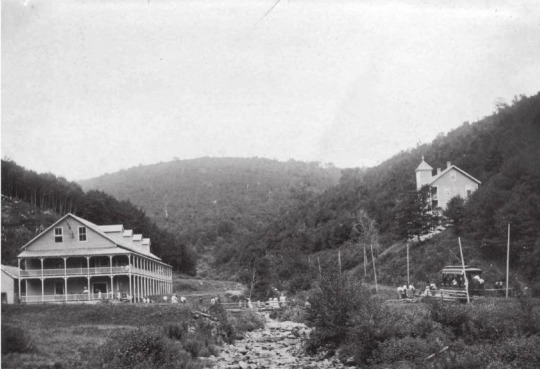
Image showing the repurposed buildings and trolley meant to transform Glastenbury. Image via obscurevermont.com.
The region sat quietly while the wilderness reclaimed it, largely remaining out of the public eye until November 12th 1945 when it became the focus of search parties and newspaper headlines. The man they were searching for was Middie Rivers, an outdoorsman who had become closely acquainted with these woods in his almost seventy-five years. An avid hunter and fisherman, Rivers was spending the day hunting with a small party including his son-in-law. While the group was stopped near Bickford Hollow, Rivers decided to move ahead of the party. By the time the clock struck 4pm he had not returned, and the concerned hunting party went out to find him. When the group saw no sign of Rivers they traveled down to Bennington and asked Fire Chief Wallace Mattison to help them search. The search went on for days and grew to include hundreds of people and soldiers from Fort Devens in Massachusetts. Hours marched on, the sun rose and set multiple times, and the hope that Rivers was fine out in the woods that he knew so well and that he would just show back up one day quickly faded when the snow began to fall. Rivers was never found and the only thing ever recovered was a single rifle cartridge from his gun.
The tragic disappearance of Middie Rivers might have slipped away into time, but instead it unfortunately became “the first one.”
In December 1946 eighteen-year-old Paula Jean Welden was a sophomore at Bennington College where she studied art, had an interest in botany, and worked at the college cafeteria. After her shift on December 1st she told her roommate she was going to do some hiking on the Long Trail, a 272-mile footpath that follows Vermont’s Green Mountains up to the border of Canada. She was dressed in sneakers, blue jeans, and a red parka, clothing that was fine for that afternoon but would offer no protection for the kind of cold that settled in after dark. She left just before 3pm and she was seen several times that afternoon. One owner of a gas station claims he saw a woman matching her description near a gravel pit, she began hitchhiking and was picked up by a local contractor who took her as far as his house which was about 2.5 miles from the beginning of the Long Trail. Once she began walking on the trail she encountered a group of hikers who answered some questions she had before they moved on in the opposite direction of Welden. According to some reports a local man named Ernest Whitman may have had one of the last encounters with Welden when she stopped to speak to him at his cabin. She asked how long she could go on the trail and he informed her it was four miles to a fork. He warned her that she was not dressed for the weather but she went on her way anyway.
When Welden’s roommate didn’t see her return that night she was not worried, she assumed she was just in another part of the college or in the library studying late. But, when she realized the next morning that Welden was still gone she went to the faculty. The president of the college called her parents in Connecticut and asked if their daughter was home with them. She was not. And when Welden’s mother was informed her daughter was also not at school she fainted on the spot.

Missing person flyer used for Paula Welden. Image via wikipedia.com.
The search for Paula Welden had one huge roadblock from the start, the structure of the search itself. At the time of her disappearance Vermont did not have its own state police force so the search was assembled and conducted by the president of Bennington College and Welden’s father. A group of 370 students and faculty went out to search for her, splitting into groups and throwing confetti on areas that were already searched so other groups knew that that area had already been looked at. In time both the Connecticut and New York state police were brought in to assist and a reward of $5,000 was offered. It was no use, no trace of Paula Welden was ever found.
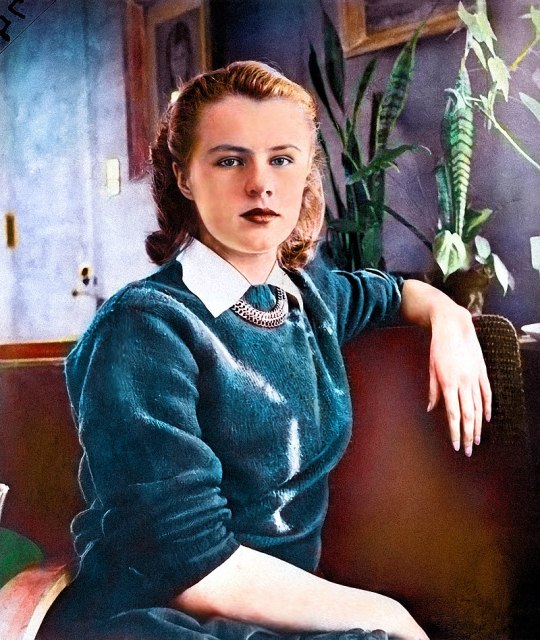
Image used in the search of Paula Welden. Image via wikipedia.com.
It is easy to say that both Middie Rivers and Paula Welden were probably unfortunate victims of the elements in the wooded expanse that includes Bennington and Glastenbury, but the story of James Tedford is much more difficult to explain away.
It was late into 1949 and James Tedford was supposed to be back home, but he was not. The sixty-eight-year-old World War II veteran had been spending some time visiting his wife and family in Fraklin, Vermont before boarding a bus in St. Albans to return back home to the Vermont Soldiers’ Home where he lived in Bennington.
Along the way back there was a stop in Burlington where Tedford ran into an old friend and the pair chatted a bit before he once again boarded the bus on the final stretch of his ride home. When the bus stopped back in Bennington it was discovered that the veteran was nowhere to be found. His last known whereabouts was on the bus on December 1st at approximately 4pm, almost exactly three years after the last known sighting of Paula Welden in the same region. There was no question that Tedford boarded the bus, not only was he seen getting back on but his suitcase, unfolded map, and unchecked bus ticket were still sitting on his seat. He was simply gone. Shockingly, it took days for anyone to put the pieces together that Tedford never returned home and a search for the man did not take place for over a week after he was last seen. No trace of James Tedford was ever found.
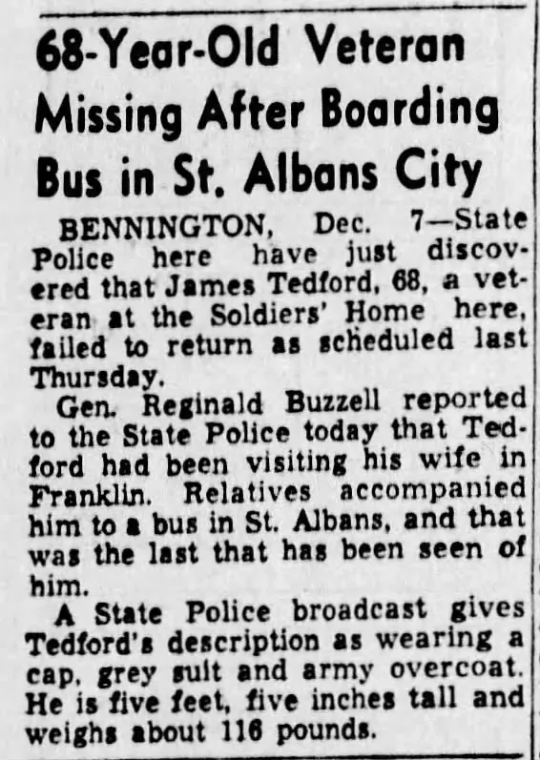
Newspaper clipping about the disappearance of James Tedford. Image via vermontdailychronicle.com.
The disappearances already seen in the region were unsettling but with the end of 1950 came a string of incidents that made some people genuinely begin to question what was going on in the wilderness around Glastenbury Mountain. The first took place on October 12th 1950 when eight-year-old Paul Jepson went missing under some eerily similar circumstances. The eight-year-old was out with his mother, some report that he was with her at the local dump that they maintained, and others state he was helping her tend to the pigs near their Glastenbury farmhouse. Allegedly he was in the family pickup truck and his mother walked away to do some work before returning to the truck and finding the child missing. Like Welden he was also wearing red and his time of disappearance was between 3 and 4pm, approximately the same timeframe that Fisher, Welden, and Tedford also all vanished. A search was launched for Jepson and hundreds of people from the local region combed through the dump, the town, and went into the mountains with no success. Bloodhounds were brought in from the New Hampshire State Police and they did pick up the scent of the boy, but it was lost at an intersection near where Welden was last seen. In the days and weeks that followed Jepson’s disappearance there were reports of motorists seeing a young boy walking along a road but subsequent searches came up empty. Paul Jepson was never seen again.
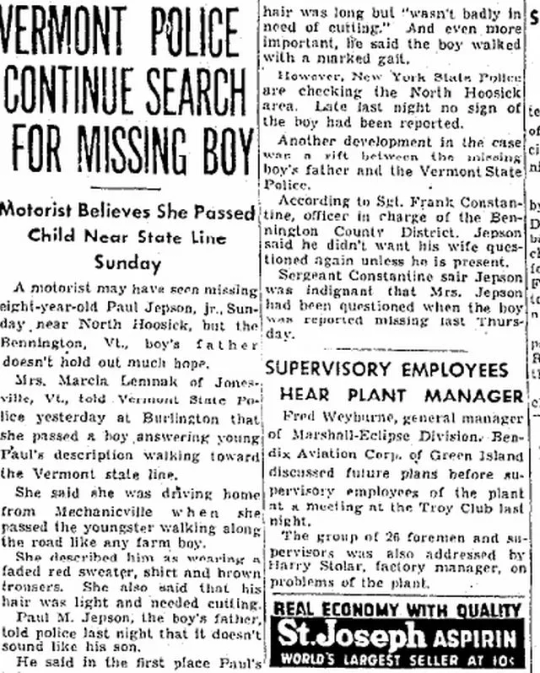
Newspaper clipping about the disappearance of Paul Jepson. Image via vermontdailychronicle.com.
With the disappearance of Jepson still fresh in the minds of the locals, they very quickly found themselves facing a growingly familiar story when two weeks later on October 28th fifty-three-year-old Freida Langer also walked into the woods and seemingly vanished. Like Middie Fisher, Langer was extremely familiar with the woods so there was nothing to be concerned about when she left her family’s camp cabin for a hike with her cousin. During their walk Langer fell into a stream near the Somerset Reservoir and rather than continue on in her wet clothes she decided to walk the half mile back to the camp where she and her husband had spent every weekend for the last decade, change clothes, and meet her cousin back in the woods to resume their walk. When Langer did not return the concerned cousin went back to the family campsite and was horrified to learn that Langer had never even made it back the half mile to change her clothes. Once again a search was launched, and once again there was no sign of Langer. But, unlike all the previous disappearances, the Langer case would have closure.
Nearly six months after Langer walked into the woods two fishermen were out on the Deerfield River when they made the gruesome discovery of human remains. They had been out that morning but were not having any luck where they were so they decided to move downstream in hopes to find more fish, instead as they moved through the water something caught their eye under the grass hanging over a large water-filled hole at the bank of the river. Langer’s body was found three miles from where she left to walk back to her cabin and it took the pair of fishermen nearly three hours to hike the three miles through intensely thick forest to Somerset Road where they hitchhiked to a home to call for help. The body was badly decomposed but there was no question that the remains were Langer, on the skull was a metal plate, the result of brain surgery that she had five years earlier. It was the surgery that led to the official conclusion that Langer must have suffered a seizure, fallen in the water, and died of accidental drowning. How the experienced hiker who was so well versed in the woods ended up two and a half miles away from her familiar destination remained unknown.
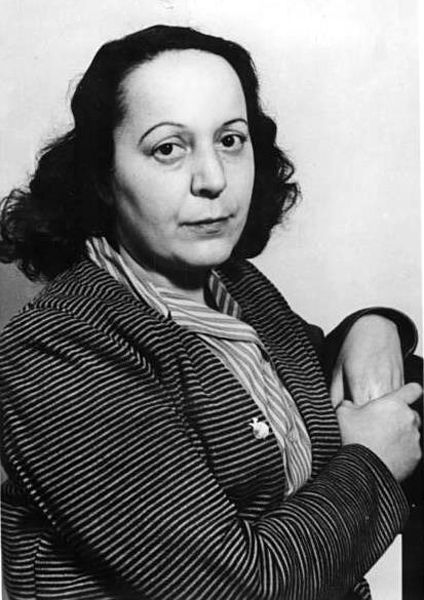
Image of Freida Langer. Image via legendsofamerica.com.
Before 1950 came to a close there was one more name that would join the unfortunate ranks of souls last seen in the wilderness of southwestern Vermont. On November 29th 1950 sixteen-year-old Martha Jeanette Jones was reported missing by her parents. But, at the time she was reported gone Jones had already been missing for an entire month. She was last known to be hitchhiking to school in Manchester and traveling through the infamous region when she too disappeared. The school was under the impression that she was home while her parents assumed she was at the school. Like so many others, Jones was never seen or heard from again.
With the number of mysterious occurrences in the Glastenbury-Bennington region there are bound to be theories about what happened to the missing. There are purely logical ones, Langer may have had a seizure and drowned, the young Paul Jepson or Paula Welden may have been kidnapped, James Tedford may have decided he no longer wanted to live at the Vermont Soldiers’ Home and silently left the bus with no one noticing, one of more of the missing may have simply succumbed to the ruthless wilderness and elements. There are these theories, and there are others that believe that there is something very abnormal going on in the woods of southwestern Vermont.
The stories go back to the Native American tales of the land being cursed and a human-swallowing rock, but there was something else they spoke of, that being the “wild men” of the woods. The idea of large, hairy creatures roaming the woods is easy to dismiss as Native American legend, but there is an account of many others seeing a similar creature in the late 1800s. According to the story a stagecoach full of people were traveling through the mountains near Glastenbury during a torrential downpour that made progress nearly impossible. The stagecoach driver came to a halt and when he climbed down with lantern in hand he noticed a large set of footprints in the mud in front of them. The tale continues that people started to come out of the stagecoach to look at the footprints when the horses began to get extremely restless. Then, something hit the stagecoach with tremendous force and everyone inside scrambled out. According to their accounts whatever was hitting the coach finally hit it with a blow strong enough to knock it on its side and through the pelting rain they saw a massive human shape, covered with hair, and two huge eyes in the darkness that turned and ran back into the woods.
The creature dubbed The Bennington Monster became yet another mystery of the region, but it was looked at a little stronger in November 1943. Before the “first” disappearance of Middie Fisher in November 1945 there was the story of Carol Herrick. Herrick was also an outdoorsman and an avid hunter who went out hunting one day with his cousin Henry. Allegedly, the two men got separated and Henry contacted authorities to try and find his cousin. Carol Herrick was found days later laying near his gun that had not been fired. The cause of death was equally confusing and disturbing, it was said that his lungs were punctured by his ribs and it appeared that he had been “squeezed” to death.
Since its earliest days the forests of southwestern Vermont have been surrounded by unsettling stories. The Native American tales of the land being cursed, man-eating rocks, and wild men live in the collective memory alongside tales of beasts attacking stagecoaches, inexplicable sounds coming from the woods, and even reports of mysterious lights and flying objects being seen over the treetops. It is the disappearances though that earned the region the name “The Bennington Triangle”, coined by author Joseph Citro in 1992. When it comes to The Bennington Triangle the years between 1945 and 1950 will forever be synonymous with the disappearances of Middie Rivers, Paula Welden, James Tedford, Paul Jepson, Freida Langer, and Martha Jeanette Jones, but these names reflect only a small sliver of the strange occurrences in the woods.
The terrifying truth is that we may never fully know the extent of the unexplained that already has, and continues to unfold, in the region of The Bennington Triangle of Vermont.
***********************************************
Sources:
Abramovich, Chad. “The Vanished Town of Glastenbury and the Bennington Triangle.” Obscure Vermont, 31 Mar. 2020, urbanpostmortem.wordpress.com/2015/04/07/the-vanished-town-of-glastenbury-and-the-bennington-triangle/.
Alexander, Kathy. “Bennington Triangle, Vermont.” Legends of America, Oct. 2023, www.legendsofamerica.com/bennington-triangle-vermont/.
Dailey, Eva. “The Bennington Triangle: The Ghost Town of Glastenbury Vermont.” The Looking Glass, 17 Oct. 2018, svclookingglass.com/4299/art/writing/the-bennington-triangle-the-ghost-town-of-glastenbury-vermont/.
Fair, Bethany. “History Space: Tale of Two VT Ghost Towns.” Burlington Free Press, 29 Oct. 2018, www.burlingtonfreepress.com/story/news/2018/10/29/history-space-tale-two-vt-ghost-towns/38202243/.
Leahey, Maynard. “Verdict of Accidental Drowning Closes Freida Langer Mystery.” The North Adams Transcript, May 14th 1951, https://www.newspapers.com/image/545381347/?terms=%22Frieda%20Langer%22&match=1
“Missing Jepson Youngster Makes Fourth Disappearance of Local Persons in 5 Years” The Bennington Evening Banner, October 24th 1950, https://www.newspapers.com/image/546025887/
“Missing Schoolgirl, 16, Brings To 6 Numbers of Persons Lost in Southern Vt.” The Burlington Free Press, December 13th 1950, https://www.newspapers.com/image/198069883/?terms=%22Paul%20Jepson%22&match=1
Page, Timothy. “Secrets of the Bennington Triangle - Vermont Daily Chronicle.” Vermont Daily Chronicle - News & Commentary for Vermont, 29 Sept. 2023, vermontdailychronicle.com/secrets-of-the-bennington-triangle/.
“74 Year Old Hunter Lost For Two Days.” The Bennington Evening Banner, November 14th 1945, https://archives.library.wcsu.edu/omeka/files/original/Michael_C._Dooling_Collection_MS_062/5262/ms062_01_18_middieRivers.pdf
Rossen, Jake. “The Lost Girl of Vermont’s ‘Bennington Triangle.’” Mental Floss, 26 Apr. 2023, www.mentalfloss.com/posts/bennington-triangle-paula-welden-vermont-mystery.
#husheduphistory#featuredarticles#history#forgottenhistory#weird history#scaryhistory#horrorhistory#VermontHistory#tragictale#weird but true#true story#truth is stranger than fiction#strangehistory#unsolvedmysteries#Glastenbury#BenningtonTriangle#unsolved#scarystories
2 notes
·
View notes
Text
Watch full quiz on: https://www.youtube.com/@QuizStoriesChannel
#DyatlovPass#Quiz#DyatlovPassIncident#UnsolvedMystery#RussiaMystery#HikingTragedy#ColdCase#UnexplainedDeaths#QuizStories#MysteryQuiz#ForensicFiles#SurvivalStory#ConspiracyTheory#ParanormalMystery#HistoryQuiz#ExpeditionDisaster#UralMountains#ColdCaseFiles#CreepyStories#StrangeDisappearance#LostInTheWilderness#ScaryHistory#Russia#SSSR#Challenge#mystery#paranormal#conspiracy theories#conspiracies#history
0 notes
Video
youtube
True Origins of Dracula | The Search for Dracula | Now Streaming in HD #DraculaOrigins #VladTheImpaler #VampireMyths #DraculaLegend #BramStoker #VampireFolklore #SupernaturalHistory #TheSearchForDracula #OccultVault #DarkHistory #GothicLegends #HauntedHistory #Transylvania #VampireLore #1996Documentary #EliWallach #FullEpisode #ClassicDocumentary #HorrorHistory #1080pRestoration #VampireRealHistory #OccultMysteries #TimelineDocumentary #ClassicHorror #Nosferatu #CinematicRestoration #ChillingMyths #DraculaCastle #OccultStudies #HistoricalMysteries #GhostStories #SupernaturalResearch #LegendOfDracula #TrueHorror #FullDocumentary #AncientLegends #DarkFolklore #ScaryHistory #TrueVampireStories #BramStokersDracula
0 notes
Photo

Journey back to Roanoke with @randomencounterproductions tonight! 7pm on twitch.tv/randomencounterprod #dnd #history #scary #scaryhistory #ushistory #roanoke #lostcolony #gamergirl https://www.instagram.com/p/BoCbO1PHrMU/?utm_source=ig_tumblr_share&igshid=t2eiygioud7a
0 notes
Photo

Voy a estar de lleno el siguiente mes con el #inktober asi que adelanto mi dibujo para el mes de octubre y noviembre, pero no queria estar con el típico concepto Halloween y dia de muertos asi que use 2 conceptos que casi no veo en estas fechas, disfraze a mi OC's de #catrin y #kuchisakeonna Posdata: como odio no saber hacer fondos T^T I'm gonna spent all my free time for the next inktober so this is the draw for the dates of October and November, These are my #oc 's and they costumes are about two concepts that I would like to see more often, a Catrin (Mexican culture) and the kuchisake onna I hope you like the illustration Btw can someone teach how to make good background for my drawings ^^! #ink #traditionaldraw #traditionalcolor #costumeparty #costume #smoking #kimono #creepypastacosplay #creepyhistory #scaryhistory #inktober2018 #devilcostume #leyendas #historiasdeterror https://www.instagram.com/p/BoRyRRKAwNT/?utm_source=ig_tumblr_share&igshid=1q5cqaieg8p3a
#inktober#catrin#kuchisakeonna#oc#ink#traditionaldraw#traditionalcolor#costumeparty#costume#smoking#kimono#creepypastacosplay#creepyhistory#scaryhistory#inktober2018#devilcostume#leyendas#historiasdeterror
0 notes
Video
youtube
5 Penampakan mengerikan yang terekam camera | Manusia Reptil?
0 notes
Text
Pieces at Peace: A Sampling of Stories and Stones for Long Lost Limbs
Tombstones are endlessly fascinating for the living. Etched in stone, decorated with their own alphabet of symbols, and telling the names (and sometimes a bit of a story) of those who walked the ground before us. We are as curious about these stone last pages in the book of life as we are about the time the body spent on earth with us. While death is promised to all, a formal burial is not. But, sometimes there are burials not for a person, but for a piece of them.
Stretching across thirty-one acres of Newport, Rhode Island are the Common Burial Ground and Island Cemeteries. The Common Burial Ground was founded in 1665 and contains 7,986 known dead from all walks of life and from multiple centuries. The number of actual inhabitants is likely higher though with hundreds more lost to the soil due to time, vandalism, and the fact that some earlier markers were simple wood planks that have long since disappeared.
By 1786 stone tombstones were heavily used and one such stone in the Common Burial Ground belongs to the Tripp family, which had to be used much earlier than anyone hoped. Wait and William Tripp were only ten and twenty-two months old when they were buried under their double headstone in 1780 and 1784. Two years later they were joined by their mother, but only part of her. Desire Tripp was the wife of William, a tanner, and they lived together in a “Large and commodious dwelling house” in Newport. On February 20th 1786 her arm was amputated by Doctor Isaac Senter who noted that the amputation took place and that the cost equated to approximately one month income, but sadly there is no record as to why her arm was amputated. On the tombstone of her children there are two carved faces of cherubs but in the center of the stone there is a carved arm to represent the arm of Desire Trapp also laid to rest at this location. Noted in an inscription along with the names and dates of she and William’s children, the epitaph reads “Also his Wifes/Arm Amputated Feb 20 1786”

The tombstone of Desire's children and her arm. Image via Hopkins vastpublicindifference.com.
While it was highly unusual for a woman to have their arm amputated and to have it memorialized on a tombstone, Desire Trapp is far from the only person to have their limb buried in its own grave.
In 1898 Richard Bertram Barrett of San Jose, California was thirteen years old and living a normal life, until one day during a hunting trip he had a most unfortunate encounter with a shotgun. The shotgun blast damaged half of his left arm beyond all repair and the decision was made to amputate. The arm was buried under a tree in Hacienda Cemetery and has its own stone marker reading solemnly, “Richard Bertram Bert Barrett His Arm Lies Here May it Rest in Peace.”
Barrett went on to lead a very successful life, eventually becoming the Chief of Sanitation for the Santa Clara County Health Department and lived to see a road named for him in the same cemetery where his arm was buried. When he passed away at the age of seventy-four he was also buried, but not with his arm. Barrett’s final resting place is Oak Hill Memorial Park, a full eleven miles away from where his arm was buried sixty-one years earlier. Today the arm has become a part of local folklore with stories saying that the arm can be seen wriggling on the ground on Halloween night.
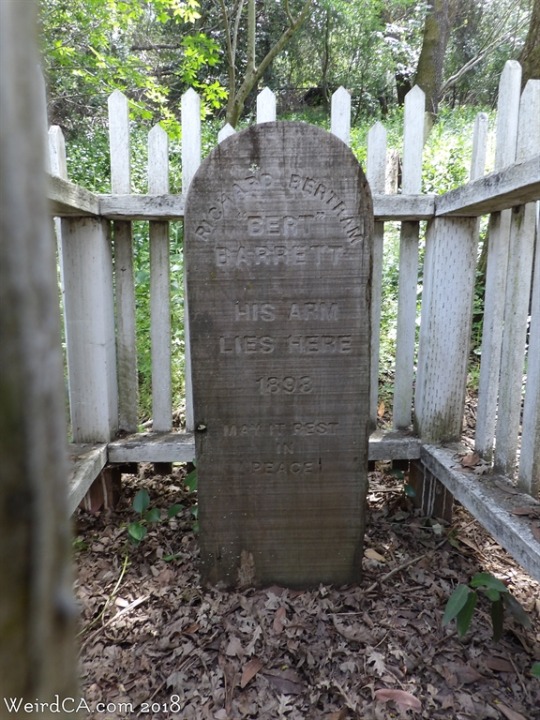
Grave of Bert Barrett's arm. Image via Weirdca.com.
In some ways the Stanley Settlement cemetery in rural northern Georgia can double as a history book of its home of Fannin County with a church and burials dating back to the mid-1800s. Among the interred are Elisha Stanely and Elv Evan Hughes, the first people to be buried here, murdered for refusing to join the Confederate army and both thrown into a single grave. It is Elisha’s son Adolphus Buel Stanley though who has the honor of having one of the more bizarre burials inside Stanley Settlement. A flat stone simply reads “The arm of Buel Stanley 1864-1946 amputated 1915 caused by fishing with dynamite in Toccoa River below Stanley Cemetery…” it goes on to inform the reader that in 1946 Stanley did not join his arm in death. Instead “…His body is buried at Macedonia Church of Christ.”
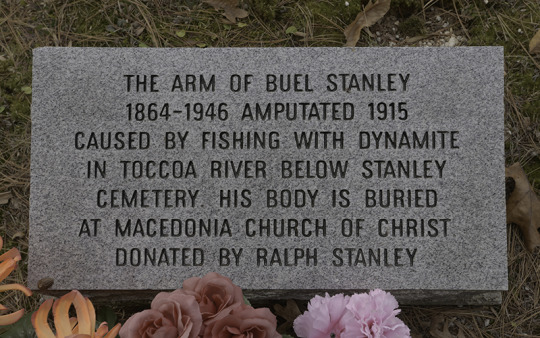
Grave of the arm of Buel Stanley. Image via Historic Rural Churches of Georgia by Tom Reed.
Losing a limb is not typically something that anyone wants, but when Captain Samuel Jones of Washington, New Hampshire learned he was going to have to part ways with one of his legs he decided he was going to make the best of it. It was 1804 when the captain was doing some construction work and his leg somehow became trapped between a building and a fence. He was eventually freed but his leg had become so mangled that it could not be saved. Captain Jones was also the owner of a local tavern so while waiting for the doctor to arrive his friends took him to the tavern and they all drank to their heart’s content. Once the leg was removed (and Smith was sober) he decided he was not done saying goodbye and decided to throw his leg a full funeral including guests and a proper burial. The leg was interred at the local cemetery, but one day some local college kids decided they wanted to steal the tombstone. After it was located in a dorm the stone was set into the ground in concrete to ensure it would never disappear again. The rest of the life of Captain Jones gets very murky, and it is believed that he ended up in Boston or Rhode Island. He was not buried with his leg.
There have been many reasons and theories as to why someone would want to properly bury their limbs, sometimes with a full funeral. According to Captain Jones, he felt that burying the leg would prevent him from feeling something doctors were aware of but could not explain, phantom leg pain. While this might have seemed funny, this discomfort where someone can still “feel” pain in their missing limb was (and is) very real and in 1878 farmer Benjamin Waldron experienced exactly what the captain was concerned about.
Benjamin Waldron was a twenty-five year old Idaho farmer and in 1878 he was working when his leg got trapped in a thresher, completely destroying it. He also went on to give his leg a proper burial in Samaria Cemetery, complete with a tombstone engraved with the image of a leg, the date of the amputation, and his initials. But something didn’t feel right after the burial, Waldron complained of pain, feeling it radiate from the leg that was no longer there, and saying that it felt uncomfortably twisted. When Waldron could not bear it anymore the leg was exhumed and sure enough, when the leg was buried it was placed in its grave at an unusual angle. Once it was re-buried in a better position Waldron finally felt relief and never felt the phantom leg pain again. Waldron finally joined his leg in the afterlife in 1914. He was also buried in Samaria Cemetery, but in a different location than his demanding leg.

Graves of Waldron and his leg. Image via Speaking of Idaho by Rickjust.com.
Waldron is not alone in his experience of feeling his disconnected limb from beyond the grave. Located in Mesquite, Texas there is a family cemetery called the Z. Motley Cemetery, serving as a permanent place of rest for members of the Motley family who still maintain it to this day.
In 1894 John Motley caught his arm in some gin machinery and as a result the seventeen-year-old was forced to live with only one arm. The arm was buried at the family cemetery but like Waldron, the young man knew something did not feel right about the arm he no longer had. He complained of feeling like there were ants crawling all over his skin. The arm was exhumed and shockingly they found that there was a way for bugs to get in and out and at the time of the exhumation they found the arm covered with ants. The arm was taken, sealed in an air-tight box, and reburied. Motley said he never felt the crawling phantom sensations again.
As luck would have it (or not), John Motley is not the only member of his family to have a separated limb buried in their family cemetery. In 1911 G.C. Motley was riding a horse when the animal took off causing him to fall and get his foot trapped in a stirrup. The injured foot became badly infected and doctors amputated it, giving it a resting place in the same Motley family cemetery as John’s arm.
Both G.C. and John Motley were buried in separate plots from their dearly departed limbs.
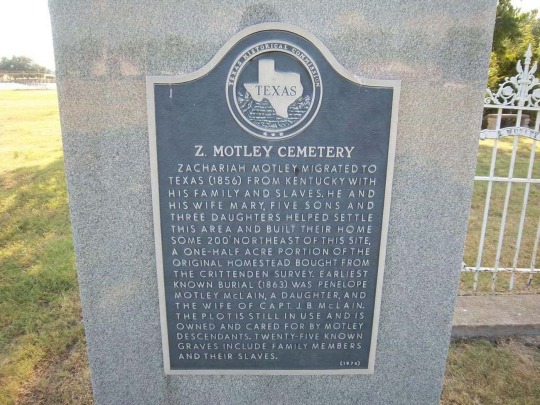
Marker for the Z. Motley Cemetery. Image via Nicolas Henderson Flickr CC BY-NC-SA 2.0
The phantom pains and sensations felt by Benjamin Waldron and John Motely and feared by Captain Samuel Jones were one factor in the burials of their limbs, but for others the need for a proper sendoff was rooted in a much more spiritual belief. Judaism, Islam, and Christianity all have varying beliefs on the burial of limbs with some faiths believing it is required to bury the limbs in a grave intended for the person when they pass or in a grave specifically for limbs. Some believe that even though the limbs are to be buried, they are not entitled to the same ceremony and prayers as a whole body. According to some Christian belief systems, the limb was required for the soul to be complete in the afterlife where it would be reunited with its owner, leading to scenarios where limbs were exhumed only to be re-buried with their person.
Perhaps it is this lack of reunion that led to the legend of Richard Bertram Barrett’s arm to come crawling out every Halloween night…it’s still looking for its human buried eleven miles away because it wants to be reunited so it too can rest.
Evidence of amputations and limb burials go back tens of thousands of years. Whether carried out at a sacred burial location or marked with a professionally engraved tombstone detailing some bad timing with dynamite, this notion, this importance, this reverence in honoring all parts of the person has endured over millennia, adapting and evolving alongside the same human creatures the practice honors. Buried alone or with family members, there are stones all over the world that speak to the feeling that even the pieces deserve peace.
****************************************************
Sources
You’ve GottaHhand it to Them: A Look at Limb Graves by Robyn S. Lacy. Spade and the Grave Death and Burial Through an Archaeological Lens. April 4th 2021. https://spadeandthegrave.com/2021/04/04/youve-gotta-hand-it-to-them-a-look-at-limb-graves/
There Are Centuries-Old Grave Sites Just For Amputated Limbs That You Can Still Visit by Laura Allan. Ranker. September 23rd 2021. https://www.ranker.com/list/grave-sites-for-amputated-limbs/laura-allan
Object Lesson: Desire Tripp and her Arm’s Gravestone by Nicole Belolan. Common Place the Journal of Early American Life. https://commonplace.online/article/object-lesson-desire-tripp-arms-gravestone/
History Bytes: Common Burying Ground. Newport Historical Society. February 25th 2016. https://newporthistory.org/history-bytes-common-burying-ground/
Stanley Church of Christ. Historic Rural Churches. https://www.hrcga.org/church/stanley-church/
Waldron's Leg by Rick Just. October 30th 2020. https://www.rickjust.com/blog/waldrons-leg
The Arm of Buel Stanley. Atlas Obscura. January 5th 2021. https://www.atlasobscura.com/places/the-arm-of-buel-stanley
Grave of Captain Jones's Leg. Atlas Obscura. August 16th 2017. https://www.atlasobscura.com/places/captain-jones-leg
Grave of Bert Barrett's Left Arm. Atlas Obscura. January 12th 2017. https://www.atlasobscura.com/places/grave-of-bert-barretts-left-arm
#husheduphistory#featuredarticles#history#forgottenhistory#weirdhistory#strangehistory#tragichistory#historyclass#truestory#truth is stranger than fiction#burials#limbburials#famousgraves#horrorhistory#scaryhistory#cemeteries#tombstones#gravestones#headstones#graveyards#graves
2 notes
·
View notes
Text
Light and Dark: The Tragic Times of the Big Bay Point Lighthouse
The waters of Lake Superior have a notorious history with those who have tried to interact with it. Responsible for over 500 shipwrecks and allegedly taking the lives of nearly 10,000 people, it has earned the nickname “Graveyard of the Great Lakes” through the most accurate and unfortunate means. Rising up over these infamous waters on the edge of a rocky cliff is the sixty-four foot tall Big Bay Point Lighthouse, a structure that seems cheery despite the unfortunate tales churning under the surface of the lake below it. This lighthouse has seen many things during its 127-year history but the water is not the only place that has seen its share of tragedy.

Map showing the number of shipwrecks in Lake Superior and calling it the Graveyard of the Great Lakes. Image via https://lakesuperiorstore.com/ShipwreckMaps
The lighthouse at Big Bay Point opened on October 20th 1896 with its white light blazing 150 feet above the water every twenty seconds to warn ships traveling nearby. The lighthouse keeper was provided with a two-story brick structure on site that could house him and his family on one side of the building and his assistant and his family on the other side. On the thirty-three acres of land there was also two cisterns, an oil house, a garage, two brick outhouses, a dock, a well house, and a brick fog signal building all situated outside a forest. It takes a certain kind of person to live the life of a lighthouse keeper, and they sometimes have very strict requirements for their crew.
The first lighthouse keeper of Big Bay Point was H. (Harry) William Prior (sometimes written as Pryor). William was the eldest of three brothers who all had experience tending to lighthouses, but it was William who became notorious for his impossibly high standards and a temper that matched his gruff red hair. William was the ruler of his domain and his extremely detailed logbooks paint the picture of a belligerent man who felt his crew was lazy and untrustworthy no matter what they did. On November 11th 1897 William left the lighthouse in order to attend the funeral of his only sister, a six-mile journey that he did on foot. When he arrived back on November 18th 1897 and saw how his assistant Ralph Heater ran the lighthouse in his absence he made his extreme disappointment known. In his logbook he wrote:
“I can not [sic] see that the assistant has done any work around the station since I left. He has not the energy to carry him down the hill and if I speak to him about it he makes no answer but goes on just as if he did not hear me; he is so much under the control of his wife he has not the hart [sic] to do anything. She has annoyed me during the season by hanging around him and hindering him from working, and she is altogether a person totally unfit to be in a place like this as she is discontented and jealous and has succeeded in making life miserable for everyone at this station.”
The sheer disdain for Heater and his wife became a theme in the logbooks. On January 1st 1898 Prior wrote about how Heater “claimed” he hurt his back, but any thought that Prior might be concerned for his coworker is quickly dispelled by the entries in February where he writes: “Mr. Heater arrived from Marquette at 6 p.m. and walked the entire distance of 33 miles in 12 hours, including two rest stops over an hour each … pretty good gait for a lame man.” This was followed by an entry on February 27th reading “Mr. Heater came across the ice to the other side of Big Bay with his wife. It is Sunday and his back is not lame today.”
Perhaps it was best for both men that Heater ended up leaving the lighthouse and his role was taken on by George Beamer, but soon after his new post began he left to serve in the Spanish American War. Upon his departure he left his wife Jennie to take his place at the lighthouse making her the only woman to ever serve at the Big Bay Point Lighthouse. Once returned though, Prior and Beamer were constantly fighting, Beamer kept insisting he could not work because he hurt his back, and by October Prior was writing:
“Asst. Beamer complains of being sick and talks of leaving the station to go home to Detroit. He is too high strung for a light keeper’s asst, between himself and his wife this season I imagine that I am keeping a Home for the Helpless Poor instead of a U.S. Lighthouse. I and my family having to do the greater part of the work while they receive the pay.”
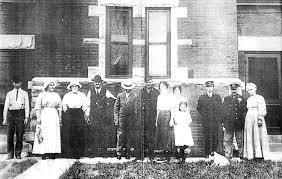
Michigan Lighthouse Keeper crew and families. Image via mynorth.com.
On November 1st 1898 Prior dismissed Beamer, his last written thoughts on him being “this Beamer���is without exception the most ungrateful and the meanest man I have ever met.” The two problematic assistants were gone, but this meant Prior needed a new assistant and his reputation was making it difficult to find a suitable replacement. Since no outsider seemed to meet his high standards, he decided to look within the lighthouse grounds and he soon made his nineteen-year-old son George his new assistant.
Perhaps the two had an understanding or they simply knew each other well enough to work together, but for over a year George and William tended to the lighthouse side by side. Then, in April of 1901 tragedy struck the Prior family. While working one day George slipped and sliced his leg down to the bone. There are differing accounts if William was there and they sought immediate treatment or if George, fearing his father’s temper, waited until he simply could not wait anymore. The nearest hospital was located in Marquette, Michigan and the thirty-mile journey by boat and then on foot had to be nothing short of agony. Young George was checked into the fifty-bed facility on April 18th and that night William, the ever-meticulous record keeper, noted in his logbook “he will have to remain in hospital for treatment.”
The injury and any delay in treatment would prove to be catastrophic to the young assistant. The wound was too severe to simply stitch up and it became infected. Eventually gangrene set in and quickly took over the tissue in his leg. Treatment and medication stopped working and almost two months later on June 13th George Prior died in the hospital. On that day his father wrote in his logbook, “1:30 p.m. Keeper summoned to Marquette to bury his son who died this morning.”
William Prior had a reputation for being the most difficult, the most demanding, and the hardest of iron fists but everything fell apart on that June morning. The death of his son completely shattered him and he spiraled into a deep state of depression. The work fell to the side and the entries in the logbook became less frequent and shorter until June 27th when the entry simply reads “General work.” That was the last entry written by the lighthouse keeper. On June 28th 1901William Prior disappeared. He was last seen walking into the woods on the grounds of the lighthouse and despite an extensive search he simply could not be found. The following fall his widow and four children piled onto a boat and headed for Marquette never to return to the lighthouse.
The following November 1902 a man named Fred Babcock was walking through the woods around the Big Bay Point Lighthouse when he made the horrible discovery. Hanging from a tree approximately half a mile from the lighthouse was a skeleton with some tufts of red hair still visible. An entry was made into the logbook that day and it read:
“Mr. Fred Babcock came to the station 12:30 pm. While hunting in the woods one and a half mile south of the station this noon he found a skeleton of a man hanging to a tree. We went to the place with him and found that the clothing and everything tally with the former keeper of this station who has been missing for seventeen months.”
Newspapers reported the finding in cold detail, writing about how the rope was tied “around the fleshless neck” and without mentioning the death of George, only reported that “…a few months over a year ago, Mr. Pryor wandered off in a fit of temporary insanity, and was never seen again…”
Unfortunately, another tragedy would be tied to the Big Bay Point Lighthouse almost fifty years after the body of William Prior was found in the woods. In 1941 the lighthouse was automated and like many other lighthouses it became a training location for the United States Army and the National Guard. In the 1950s large guns were installed on the cliff to use during practice shooting over Lake Superior and the soldiers camped out in the surrounding fields and woods. One of the men stationed at Big Bay Point was Korean War veteran and member of the 768th anti-aircraft battalion at Camp McCoy in Wisconsin, 38-year-old Lieutenant Coleman Peterson who was there with his wife Charlotte. Lt. Peterson was known to be a very jealous man and on at least one occasion he and Charlotte had gotten into a fight outside the nearby Lumberjack Tavern because he accused her of flirting with another soldier stationed near the Big Bay Lighthouse.
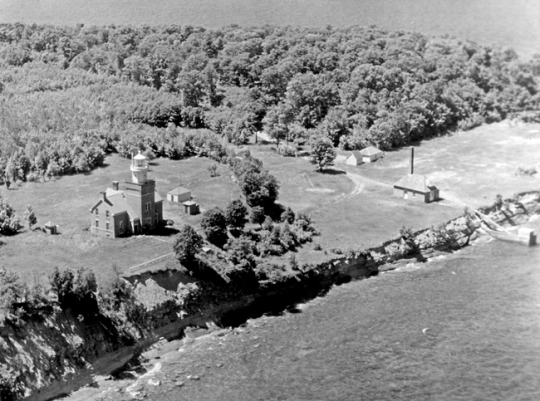
Aerial photo of the Big Bay Point Lighthouse circa 1947. Image via https://www.lighthousefriends.com.
The Lumberjack Tavern was less than five miles from the lighthouse and it was frequented by those stationed there. On the night of July 31st 1952 Charlotte was out drinking at the tavern and she returned back home with a black eye. When her husband confronted her about it, she told him that the owner of the tavern raped her. Peterson left for the tavern and when he arrived just before 12:30 a.m. he walked through the screen door, went straight up to the bar where owner Maurice (Mike) Chenoweth was standing, and shot him six times at point blank range with a 9 mm German Luger automatic pistol. With Chenoweth dead behind the bar he calmly turned around and walked back out into the night as if the entire scene never happened.
Peterson was arrested and when he was brought into court on September 15th 1952 he was represented by John D. Voelker. Voelker used a defense called “irresistible impulse”, stating that Peterson killed Chenoweth due to a bout of temporary insanity. It was a defense that had not been used since 1886 but after only a few hours Peterson was found not guilty by reason of insanity on September 23, 1952. But, as stated in the court, this insanity was only temporary. He was examined days later, declared sane, and released to resume a normal life. Some accounts state that he fled the region, never paying Voelker and soon divorcing Charlotte. No evidence was ever found pointing to Chenoweth being guilty of the crime.
Peterson was free but John D. Voelker was not done with this case. Under the pen name Robert Traver he wrote the book Anatomy of a Murder based on the Peterson murder case. The book was on the bestseller list for sixty-five consecutive weeks and has sold more than four million copies in twenty languages. In 1959 the book was adapted into a film starring Jimmy Stewart. A rare occurrence at the time, parts of the film were shot on location at the Lumberjack Tavern where the original murder took place and in 2012 the film was selected for preservation by the Library of Congress for being "culturally, historically, or aesthetically significant".

The Lumerjack Tavern with sign advertising Anatomy of a Murder outside. Image via remax.com.
Today, the Lumberjack Tavern is still standing, its walls filled with newspaper clippings and with signs out front proclaiming it as the actual place where the crimes of Anatomy of a Murder unfolded. The Big Bay Point Lighthouse also still stands in the same place where tragedy unfolded in 1901. Today, it operates as a bed and breakfast and its current owners are well aware of its history, partially because there are reports that its past is still very much present at the lighthouse. As told by the current owner to NorthernExpress.com in 2021, “It was haunted when I acquired it…” and there have been reports of footsteps, things moving in other rooms, faucets turning on, lights turning on and off, and some report seeing split-second glimpses of the red-haired William Prior in mirrors, still watching over the lighthouse he lived for and that eventually took the lives of both him and his son.
When the Big Bay Point Lighthouse was officially opened it was meant to be a literal beacon, guiding those away from danger. Its light could not save everyone though, and within its first fifty-two years both William Prior and Lieutenant Coleman Peterson succumbed to “temporary insanity” and became tied to some of the darkest chapters of the lighthouse’s history.

Big Bay Point Lighthouse circa 2019. Image via Rossograph on Wikipedia.com
**********************************************
Sources:
The Tragedy and Haunting at The Big Bay Lighthouse by Mike Sonnenburg. June 6th 2016. lostinmichigan.net/tragedy-haunting-big-bay-lighthouse/.
Do You Dare Stay the Night at Michigan’s Most Haunted Lighthouse? by Dianna Stampfler. October 16th 2019. https://mynorth.com/2019/10/michigans-most-haunted-lighthouse-big-bay-point-lighthouse/
The Haunting of Big Bay Point Light of the Souls by Brighid Driscoll. Northern Express October 23rd 2021. https://www.northernexpress.com/news/feature/the-haunting-of-big-bay-point/
Big Bay Point Lighthouse https://www.lighthousefriends.com/light.asp?ID=574
Memories of a Murder by Lisa Didier. The Chicago Tribune August 20th 1989.
https://www.chicagotribune.com/news/ct-xpm-1989-08-20-8901060128-story.html
Seen on Screen: Anatomy of a Murder in Big Bay by Talia Salem. June 30th 2014.
#husheduphistory#featuredarticles#michiganhistory#michigan#BigBayPointLighthouse#LighthouseHistory#HauntedHistory#AnatomyofaMurder#famouscrime#truecrime#tragicstory#tragictale#tragichistory#sadhistory#scaryhistory#famouscourtcases#famousbooks#lighthouse#historyclass#truth is stranger than fiction#truestory#forgottenhistory#strangehistory#weirdhistory
3 notes
·
View notes
Text
Ghost Blimp: The Mystery and Missing on the L-8
On Sunday, August 16th 1942 Richard L. Johnston was going about his business. He had just finished waxing his car in Dale City, California when he looked up and saw something huge creeping out of the sky and towards his house. Suddenly it hit a utility pole, electrical wires broke sending sparks cascading down to the street, and Johnson ran into the house to protect his mother. When he came back outside there was a large group of people in the street including Fire Deputy Marshal Sean Wood and Johnston’s next door neighbor, volunteer fireman William Morris. Johnston’s car was completely hidden under a massive fold of what looked like canvas. When Johnston woke up that morning he probably didn’t expect that a blimp would land on his car that day. And yet, moments later the scene became even more bizarre.
In August 1942 the United States Navy was on high alert. Within nine months after entering World War II Japanese submarines sunk at least six Allied ships off the American west coast and shelled one of California’s largest oil drilling facilities. The fear of another attack on American soil was high and in order to keep an eye on the sea along the west coast the Navy took to the air, deploying blimps to cruise over the ocean and watch for any suspicious activity.

World War II Navy blimp. Image via Wikimedia Commons.
The blimp that landed on Johnson’s car was the L-8 airship, acquired by the Navy from the Goodyear company and commissioned on March 5, 1942. It was an excellent machine, completing over 1,000 trips and never requiring any work beyond routine maintenance. The two-man crew tasked with piloting the airship had records as impeccable as the craft itself. Lieutenant Ernest Dewitt Cody was a 1938 graduate of Annapolis and although he was only twenty-seven years old he was highly regarded with his commanding officer describing him as “one of the most capable pilots and one of the most able officers” under his command. Cody was relatively new to flying LTA (lighter-than-air) airships, but in April 1942 he proved his ability when he flew the L-8 to deliver cargo to the USS Hornet before the ship departed for Doolittle’s Raid over Tokyo. It was that trip that earned him his promotion to Lieutenant in June 1942. Ensign Charles Ellis Adams was eleven years older than Cody and had twenty years of experience flying LTA airships, but only earned his commission the day before their flight together making his trip with Cody his first flight as an officer.

Lieutenant Ernest Dewitt Cody and Ensign Charles Ellis Adams.

The L-8 delivering cargo to the USS Hornet. Image via National Archives.
Their task together was a routine anti-submarine mission, fly out from Treasure Island, patrol a fifty-mile radius of San Francisco, then head to the Farallon Islands before heading back to Treasure Island. When they left Treasure Island at 6:03am there was approximately five miles of visibility with the Golden Gate Bridge off in the distance. At 7:38am Cody radioed Moffett Field and reported their location as being four miles east of the Farallon Islands. Four minutes later Moffett Field received a second message from Cody, “Am investigating suspicious oil slick—stand by.” Since an oil slick could indicate an enemy submarine below the waves it was not unusual for the airship to investigate the scene. As the L-8 descended closer to the sea its movements were seen by a fishing boat, the Daisy Gray, and a Liberty cargo ship, Albert Gallatin. Apprehensive about seeing the Navy airship creep closer to the surface of the water and then set off two flares, the ship crews pulled in their nets, manned their guns, and nervously waited to see what happened next. But, as they watched the L-8 nothing out of the ordinary happened. The blimp circled for about an hour and crews from both ships could see two men in the gondola. At approximately 9am the blimp again rose into the air and restarted its route back toward San Francisco. Everything appeared normal to the ships and spectators below, but personnel at Moffett Field were getting nervous, they had not heard a word from the L-8 since 7:42am and were not able to reestablish any communication. Two Vought OS2U Kingfisher floatplanes were sent to look for the blimp and other aircraft were asked to keep their eyes open.

The intended flight path of the L-8 aircraft. Image via unsolvedmysteries.fandom.com.
At approximately 10:49am a series of blimp sightings began to roll in. A Pan American Clipper pilot reported seeing the blimp over the Golden Gate Bridge, then at 11am one of the Kingfishers spotted the L-8 three miles west of Salada Beach at approximately 2,000 feet. Although a height of 2,000 feet would typically be avoided by an airship for safety reasons, there was no indication of the ship being out of control or in danger and it began to descend. The next plane to spot the blimp, an Army P-38 pilot, also saw no indication that the airship or its crew was in any distress when it was seen near Mile Rock, seemingly on its way back to Treasure Island. Within minutes an off-duty seaman named Richard Quam saw the L-8 as he was driving along the highway between San Mateo and San Francisco and he decided to take a picture of the sight. He may have been the first person to capture that something was amiss, the blimp was now noticeably bending in the middle.

The L-8 airship visible sagging as it flew over Daly City. Image via National Archives.
Things began to happen quickly. At approximately 11:15am the L-8 was seen approaching the shore of Ocean Beach in San Francisco but its motors were now silent and there was noticeable sagging. It touched down on the beach for a moment but kept moving until it hit the side of a hill, knocking off one of its 325lb depth chargers. Now carrying 300lbs less, the airship again rose, clearing the hill, and moving further inland. Thousands of people now watched as the L-8 staggered overhead obviously in peril. But, according to witnesses, the ship was not unmanned, in a later interview seventeen-year-old C.E. Taylor told reporters that as the blimp descended he was watching the cabin through his binoculars and that two men were clearly visible inside the entire time.
Finally, at 11:30am the blimp came to a clumsy rest on top of Richard Johnston’s freshly waxed car. Sirens blared and firemen surrounded the blimp, slashing it open in an attempt to save Cody and Adams inside. But, when the rescuers got to the gondola they found a scene that made no sense. The door was open, the microphone for communication was hanging from the doorway, a hat was resting on the controls, the life raft and all parachutes were still in place, but Cody and Adams were nowhere to be found.
Once the initial shock of the crash wore off a feeling of worry began to quickly take over. The L-8 was traveling an extremely visible route and was tracked and seen by hundreds of people and ships, with many reporting the same as young C. E. Taylor, that the men were visible inside the cabin. The Navy immediately launched a search for Cody and Adams and the craft was inspected for any clues to solve the disappearance. The engines were in perfect running order, the ignition switches were on, and there was four hours of fuel left. The only thing that was unusual on board was that the blimp's batteries were drained and part of the fuel supply had been dumped out with no obvious explanation why.
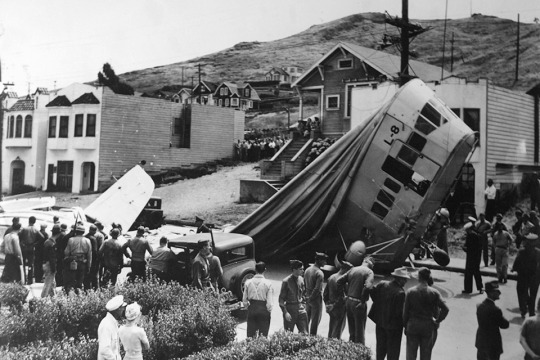
The scene after the crash of the L-8. Image via National Archives.
For three days the shore where the blimp initially crashed and the Pacific coastline was heavily searched but there was no trace of the two missing men. A board of investigation was convened by Navy Commander Francis Connell and over the course of seven days thirty-five witnesses gave their testimony of watching the L-8 hover overhead with nothing seeming suspect. Multiple people both on land and at sea at the time reported seeing the men inside and there being no indication that they ever fell or jumped out of the gondola. In the end it was determined that "no fire, no submersion, no misconduct, and no missiles struck the L-8.” While that may have answered some questions the big one still remained, what happened on the L-8 between 7:42am and 11:15am that made two Navy officers stop communication and vanish before crashing their blimp in a residential neighborhood?
Unfortunately, there were many theories but no concrete answers to that question. Some believed it was a simple tragic accident, that a malfunction with the door led to one man falling out at a low altitude and the other following him out in an attempt to save him before they were both lost to the sea. Others proposed much more elaborate theories, that the men were secret spies, that they were lured close to the surface of the water and grabbed by enemy forces, and some even said that the men ended up killing each other by falling out of the blimp during an argument over a woman. Some guesses tried to remain optimistic, that the men fell out but they were able to swim to shore and would be found hiking back to civilization any day now. Maybe they were picked up by a passenger ship after falling from the aircraft, they just had to wait until they were returned home. But, time ticked forward and the men never reappeared. Shortly after the crash the wives of both men were told that their husbands were officially missing. It was becoming painfully obvious this was not going to change and one year after their disappearance the men were declared dead. The Navy officially classified the incident as “100% Unknown/ Undetermined.”
The L-8 was repaired and continued to be used as a training vessel until the end of World War II when it was returned to Goodyear Tire and Rubber Company. It was refurbished, renamed America, and was used to broadcast sports events until it was finally retired in 1982.
Nearly eighty years after the disappearance of Lieutenant Ernest Dewitt Cody and Ensign Charles Ellis Adams there is still no official explanation as to what happened on that clear August morning over the Pacific coast
After its retirement the gondola of the L-8 was fully restored and is currently exhibited at the National Museum of Naval Aviation in Pensacola, Florida.

The refurbished gondola of the L-8 on display at the National Museum of Naval Aviation. Image via www.history.navy.mil.
*************************************************
Sources:
Mystery of the Ghost Blimp by John J. Geoghegan https://www.historynet.com/mystery-of-the-ghost-blimp.htm.
The Crew of the L- 8, https://unsolvedmysteries.fandom.com/wiki/The_Crew_of_the_L-8
The Bizarre Tale Of The World War II Ghost Blimp And Its Missing Crew by Gina Dimuro, https://allthatsinteresting.com/ghost-blimp
In 1942, a war blimp fell out of the sky onto Daly City. Its crew was never found by Katie Dowd and Andrew Chamings, https://www.sfgate.com/sfhistory/article/SF-Ghost-blimp-Daly-City-15739903.php
Ghost Blimp Mystery of WW2 – Crashed in San Francisco & Crew Was Never Found by Ruslan Budnik, https://www.warhistoryonline.com/instant-articles/mystical-disappearance-pilots.html.
#HushedUpHistory#featured articles#world war ii#WWII#airship#WorldWarIIhistory#wwii history#californiahistory#unsolvedmysteries#unsolved#mystery#weirdhistory#strangehistory#scaryhistory#forgottenhistory#horrorstory#scarystory#historyclass#historyisnotborning#creepyhistory#wheredidtheygo#historicmystery#historiesmysteries#truth is stranger than fiction#truestory#weirdstory#blimp#L8#ghostblimp
73 notes
·
View notes
Text
Bloodthristy Greed: The Terrible Trail of the Witch of Yorkshire
William Perigo didn’t know what to do anymore. For over a year he and his wife Rebecca trusted Mary and Miss Blythe with their entire wellbeing, but things were not going to plan. Rebecca was still not well, and William could not ask Miss Blythe directly what was going on. After all, they had never met Miss Blythe, they only communicated with her through Mary, her messenger, who took great care to make sure all of Miss Blythe’s requirements were impeccably met. The Perigos followed every order but this was no doctor advising them. Miss Blythe was a psychic and reader “of the stars.”
Most recently Mary brought distressing news from the psychic, an illness was headed to William and Rebecca. But, they had nothing to fear. Mary brought them a solution, a special powder crafted by Miss Blythe that was to be eaten with puddings and special honey. They ate with confidence they were going to be safe. They were absolutely wrong.
Mary Bateman was born to a North Yorkshire family in the 1760s. She was fortunate to be born into a comfortable family, but that comfort did not keep her from developing some unfortunate habits. When Mary was very young she discovered a love of stealing and by the time she left home at the age of twelve to embark on a life as a domestic servant she had already developed some very sticky hands. But, her hobby was risky, and she often got caught. She was caught so many times that she eventually ran out of local clients, all more than aware of her reputation. With her list of potential employers running out she moved to Leeds where a friend of her mother arranged for her to get work as a seamstress. It was honest work, but Mary wanted more so she began her own side business, claiming she was a witch who could tell the future, remove curses, and concoct love potions.
Leeds could have been a fresh start for Mary but old habits die hard and she could not stop stealing any chance she got. When she married wheelwright John Bateman he probably did not envision the life he was in for, having to pack up and move on a regular basis to avoid his wife’s crimes being discovered. Perhaps looking back and seeing how much her life was uprooted by her stealing, or seeing how this was going to become more and more difficult with John and their children in tow, Mary changed gears and began working for Mrs. Moore, the “seventh child of a seventh child” who was capable of using supernatural means to avenge anyone who wronged her clients. It was after working with Mrs. Moore that Mary began working with the illusive and powerful Miss Blythe.

Building that housed a former home of Mary Bateman in Leeds. Image via Lajmmoore - Own work, CC BY-SA 4.0, https://commons.wikimedia.org/w/index.php?curid=115947286
Working with Miss Blythe was very lucrative. People came to Mary’s home and paid her well for relaying their woes to the great and powerful Miss Blythe who would undoubtedly work her magic, consult the skies, create charms, and guide them to their best life. Miss Blythe revealed all. But one thing that Mary did not reveal was that Miss Blythe (and Mrs. Moore before her) were not real people. The sought-after psychic that Mary had a seemingly exclusive connection to was completely made up. What was entirely real was the money people willingly put into Mary’s hands, for access to Miss Blythe, again and again and again.
In 1803 Mary met three women from the Kitchin family, two Quaker sisters and their mother. The women owned a drapery shop in Leeds and they all became very friendly with Mary even helping them in their shop. Of course, before long the Kitchins began asking if they could hear their fortunes from Miss Blythe, and Mary was happy to oblige, after payment of course. At first things probably seemed fine to the members of the Kitchin family, but then they started getting sick.
First it was one sister who fell mysteriously ill. It seemed obvious to get Mary to ask the powerful Miss Blythe for help, and Mary obliged, bringing them powders and medicines from the psychic that they were assured would ease the illness. Totally unaware that there was no Miss Blythe, the sister took the “medicine”, but she died shortly after. Then, the next sister passed away, and they were both quickly followed by their mother. What caused this sudden awful loss of life? According to Mary the three women died of plague. It was a convenient answer, fear of infection kept everyone away from the women’s home while Mary stripped it bare of all of their belongings. Allegedly there was only one person who thought the entire ordeal was suspicious and brought up the possibility of poisoning. But the Kitchins had no family, so the accusation was never followed up on. Like so many times in her life, Mary quickly packed up and moved away, but this time the crimes she was running from were far more serious. This was not about the Kitchin’s stolen items, Mary had indeed poisoned them making Mary much more than a thief, she was now a cold-blooded killer.
Like every other crime committed by Mary, the deaths of the Kitchin family taught her no lessons, put zero weight onto her conscious, and she eventually fell back into her life of deception. By 1806 she had already left a trail of fraud convincing people to pay her money to resolve fabricated hardships and betrayals but now Mary came up with a new method, one that was far more inclusive and harder to disprove. Mary decided to enter into the business of apocalyptic prophecy and her assistant this time was not a non-existent psychic, it was her chickens.
According to Mary, her chickens were laying eggs inscribed with messages warning of the end of days and people flocked to her home to see it with their own eyes. Mary, who spoke openly about her “Prophet Chickens of Leeds”, would meet the people and present them with an egg clearly bearing the words “Crist is coming” on its shell. The visitors became frantic, what could they do if the apocalypse was coming? How lucky for them that Mary was well versed in magical protection and that she could guarantee their salvation…for a price. It was simple, pay Mary and her chickens a penny and she handed you a scrap of paper with “JC” written on it, a ticket to ensure passage to heaven. This latest ploy of Mary’s was comparatively short-lived. A doctor did not believe her claims and decided to spy on her to see what was really going on. His suspicions were correct, he personally witnessed Mary writing the words on the eggshells using vinegar which reacted with the shells and caused the words to “appear” on the egg. After writing the words on the shell she would take the egg and force it back into the body of her chickens to give the appearance of the prophetic eggs being freshly laid with the words already on them. The doctor exposed Mary’s fraudulent behavior but amazingly, she was never punished. She sold the chickens to a neighbor and continued with her life. It was a tragically missed opportunity. If punishment had finally come to her over her prophetic chickens, the Perigo family would have had a very different history.

Illustration of Mary Bateman and a prophetic egg. Image public domain.
In the same year as her failed apocalyptic chicken plot Mary was introduced to William and Rebecca Perigo. The couple lived in Bramley and Rebecca suffered from a “nervous” disorder that she was told was a result of an “evil wish” placed upon her. Wishing to be rid of this negativity the Perigos reached out to the familiar name of Mary Bateman who was happy to connect them with her old friend, the powerful, elusive, and completely fabricated Miss Blythe.
According to Mary the instructions from Miss Blythe were very specific and had to be followed exactly in order to remove the evil wish from Rebecca. The Perigos gave banknotes to Miss Blythe who then sewed them into silk bags, instructing them that these bags had to be sewn into the corners of Rebecca’s bed for eighteen months. This was only the start though, Rebecca’s condition was complex and Miss Blythe was going to need some time…and money…to get to the bottom of her supernatural affliction. The Perigos never once questioned Mary’s messages “from” Miss Blythe. They willingly handed over money again and again, being told by Mary that Miss Blythe needed the cash in order to purchase an exhaustive list of magical supplies that somehow grew to include silverware and a new bed. There was no proof of her demands. Mary said that Miss Blythe required every letter requesting payments to be burned so that evil spirits could not read the contents and know what she was doing for the Perigos. The pair might have thought things were going well but one day Mary’s message took a dark turn. According to Miss Blythe, an illness was headed for the Perigos “in the month of May next, either t'one or both, but I think both, but the works of God must have its course.” This was extremely distressing news, but not to worry, Miss Blythe had a cure.
William and Rebecca followed the instructions precisely as they were told. When they received the magical powder from Miss Blythe they sprinkled it on their puddings, ate them with the pot of special honey, and told no one. Only they were allowed to eat this food and no doctor could be called, involving anyone else would guarantee the illness would fall upon them with even more severity.
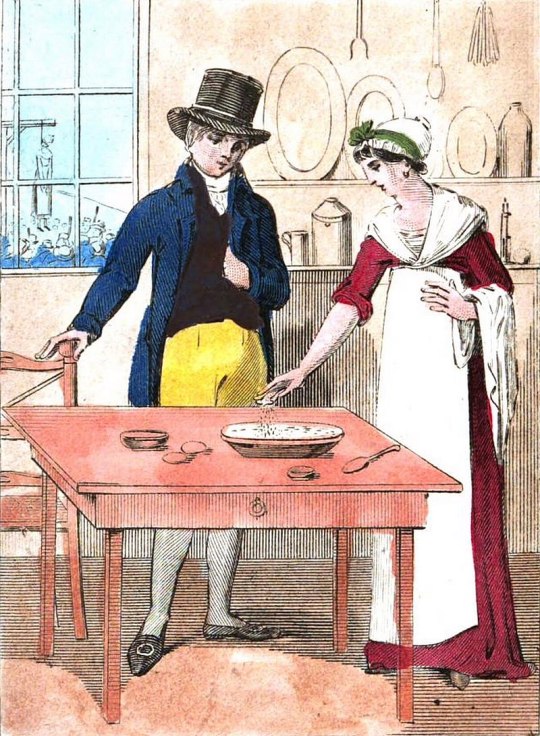
Illustration of Mary Bateman mixing the magical powders into food. Image public domain.
The reaction was swift. The couple fell horribly ill with William later describing that “a violent heat came out of his mouth, which was very sore, that his lips were black, and that he had a most violent pain in his head twenty times worse than a common head-ache, (and that) everything appeared green to him." He also suffered from a "violent complaint in his bowels." Depending on the point of view, he was lucky to have endured this, his wife did not. On May 24th 1807 Rebecca died after being poisoned by Mary Bateman.
Unbelievably, this huge red flag went unseen by William Perigo. Surely this was the illness predicted by the great and powerful Miss Blythe, and with Rebecca dead he needed guidance more than ever. For two years William continued to use Mary to connect to Miss Blythe, even when the psychic said she needed more money and all of his dead wife’s clothing. At some point William finally grew suspicious, why wasn’t anything going to plan? He went back to where it all started, with the silk bags in the corners of Rebecca’s bed. When he tore open the stitches he found none of the banknotes they had supplied to Miss Blythe. The bags were full of garbage. This, finally, was the last straw for William Perigo.
When William confronted Mary about the silk bags her response was simple and infuriating. Obviously the problem was that he opened the bags too early, that’s why they were full of trash and not the banknotes given to Miss Blythe. William’s response was that he was actually too late and he left Mary, returning to her the following day with Constable Driffield in tow. This encounter with Mary was markedly different from the previous day. Now, Mary confronted William loudly claiming that a bottle he gave her was full of poison and that he almost killed her and Mr. Bateman who was severely ill from it. At this accusation the Constable stepped forward and arrested Mary Bateman. A search of her house found it filled with everything Miss Blythe had demanded of the Perigos in order to save them from the “evil wish” placed on them.
On March 17th 1809 the trial of Mary Bateman began at York Castle with Mary as adamant as ever that she was totally and completely innocent of the accusations of murder. According to the newspaper Hull Packet, she appeared in court as “very plausible, of an appearance sedate and respectable and, as Shakespeare says of Richard, ‘with a tongue in her head that would weedle the devil.” Everything began to quickly unravel for Mary as more witnesses came forward and more information came to light. It was soon revealed that there was no Miss Blythe, or a Mrs. Moore before her, that the psychics were a complete fabrication that Mary used to commit her crimes for years. As it turned out, William and Rebecca were not the only people that Mary had recently attempted to sink her venomous claws into and her neighbors, the Snowden family, were subjected to a very similar scam. According to the Hull Packet, the wife of James Snowden had a premonition that one of their children would be drowned so Mary stepped in and offered the services of Miss Blythe to prevent the tragedy. Like the Perigos the Snowdens were instructed to give Miss Blythe money and also a watch that she would place in bags to be sewn into the corners of their bed. Then the family was told that to prevent their son from drowning and their daughter from being abandoned they had to pick up and move from Leeds to Bowling. The family was instructed in “taking the bed with the watch and money in it, with them, but leaving a considerable portion of their property in their house at Leeds, and giving Mary Bateman the key.” While they were away from home the family was sent “a dose” of magical powder from Miss Blythe that the family never ingested. Upon investigation the money and watch was gone from the bed and the Snowden home was looted. The trial lasted only eleven hours and a verdict came easily. Mary Bateman was found guilty and sentenced to death.
On March 20th 1809 Mary Bateman, “The Witch of Yorkshire” was marched up to the gallows at York Castle alongside two other prisoners. She had tried everything in her power to avoid this fate, clinging to her claims of innocence and even claiming she was pregnant and therefor could not be hanged. But nothing worked, her history of crime was too extensive, too definite, and a medical examination concluded that she was not pregnant meaning her sentence stood. The trial of Mary Bateman was a sensation and thousands of people attended the execution. Mary claimed her innocence until her last breath.

Modern day York Castle. Image via wikipedia.com
With Mary’s lifeless body cut down from the gallows the question now was what to do with her. There was no burial for the Witch of Yorkshire, her body was sent to the Leeds Infirmary where it was dissected and displayed in front of a paying audience over the course of three days. Tickets cost three pence each and the first day was reserved for medical students while day two and three were open first to the professional men of Leeds and then to women.
She was hanged, she was dissected as a public spectacle, and yet that was still not the end for Mary Bateman. After her dissection strips of her skin were removed, tanned into leather, and sold as magical charms to ward off evil. Other pieces of her skin were used to make purses. The governor of Ripon Prison became owner of the tip of her tongue. Two books were bound in her skin. And lastly, her skeleton was propped up and put on display for nearly two centuries, first residing at the Leeds Medical School before being moved to the Thackray Medical Museum until 2015.
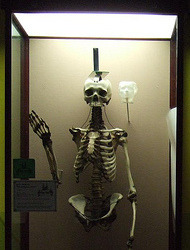
The skeleton of Mary Bateman. Image via ExecutedToday.com
Currently, the skeleton of Mary Bateman is held at Leeds University, an iconic historical item and a grim reminder of the extent of fraud, deception, and cold-blooded murder carried out by The Witch of Yorkshire.
*********************************************************************
Sources:
The Terrible Crimes and False Wonders of Mary Bateman, the Witch of Yorkshire by Catherine Curzon
https://www.mentalfloss.com/article/577601/mary-bateman-witch-yorkshire-murder
Hull Packet “Witchcraft”
https://callisto.ggsrv.com/imgsrv/FastFetch/UBER2/WO1_HLPA_1808_11_01-0004?legacy=no&crop=1539+70+1601+5601&scale=0.5&format=jpeg
Mary Bateman: The Leeds Witch by Keith Spence
https://www.on-magazine.co.uk/yorkshire/stories/the-leeds-witch/
The Yorkshire Witch: The Life & Trial of Mary Bateman by Fiona Guy
https://www.crimetraveller.org/2017/04/the-yorkshire-witch-mary-bateman/
#husheduphistory#featuredarticles#England#EnglishHistory#EnglishCrimeHistory#historiccrime#truecrime#BritishHistory#LeedsHistory#HistoryofLeeds#BritishLegalHistory#weirdhistory#scaryhistory#strangehistory#horrorstory#scarystory#weirdstory#YorkshireWitch#historyclass#spookyhistory#truehorror#historicserialkiller#serialkiller#WitchofYorkshire#truestory#historyiscool#historyisnotboring#history#truecrimestory#famoustrial
4 notes
·
View notes
Text
Off the Hook: The Bloody Secrets of Room 1046
Working in a hotel means encountering many kinds of people, but there was something very odd about Roland T. Owen. When he walked into the Hotel President of Kansas City, Missouri the year was brand new, and people may have still been celebrating the arrival of 1935 on this January 2nd afternoon. Owen walked into the hotel appearing as a normal well-dressed young man, but he had some distinguishing features, a large bald scar above his left temple and a cauliflower ear. Perhaps he was a boxer or a wrestler in town for an event, and maybe that is why he only booked one night. He didn’t have many requests, only that he needed an interior room on a high floor and as he and bellhop Randolph Propst made their way up to the tenth floor room he quietly commented how he had spent the previous night at the neighboring Hotel Muehlebach but the price of five dollars a night was too high for his liking. The pair entered Room 1046 and before heading back to the hotel lobby Propst watched as Owen unpacked all of his belongings: a comb, a hairbrush, and some toothpaste. Owen left the hotel shortly after checking in, leaving as quietly as he arrived.
A short time later when hotel maid Mary Soptic went into Owen’s room she was surprised to see him there. The night before a woman was occupying the room and she seemed unaware that she had left and Owen had now taken her place. The room was dimly lit with one lamp and Owen apologized for sitting in the dark, telling her that it was ok, she could clean the room while he was there. She obliged but they were not in each other’s company long. A few minutes after Soptic’s arrival Owen stood up, brushed his hair, and left the room, telling her it was ok for her to leave the room unlocked because he was expecting some friends to arrive shortly. Their next meeting would only be stranger. At 4pm Soptic returned to Owen’s room with fresh towels and when she entered she found Owen laying on his bed fully clothed in near darkness. There was a note sitting on the bedside table reading “Don: I will be back in fifteen minutes. Wait.”

The Hotel President circa 2012. Image via wikipedia.com.
The strange visit of Roland Owen continued into the next day with Soptic again being the main witness to the oddities unfolding. Soptic later commented about the young man that “He was either worried about something or afraid.” On the morning after Owen’s arrival Soptic went to Room 1046 for the regularly scheduled cleaning. When she arrived at the room the door was locked. This was not overly unusual, she figured Owen was probably out, but when she opened the door with her own key she found him again sitting in the dark. She went about her cleaning when the phone rang. Owen answered it but only said to the person on the other line, “No, Don, I don’t want to eat. I am not hungry. I just had breakfast. No. I am not hungry.” He hung up and made small talk with the maid, asking about her job and if the hotel was residential before she left. She would be back again at 4pm with more fresh towels for the increasingly unnerving visitor. When she returned at that hour though, something was going on. The door was again locked but this time there were two male voices coming from behind it that went silent when she knocked. A deep voice not belonging to Owen asked what she wanted and when she replied that she was bringing fresh towels he told her “We don’t need any” and sent her away. She left with the new towels knowing this was not true, she had taken all the towels from the room earlier that morning when Owen was speaking on the phone. The hotel staff did not hear from Owen directly for the rest of the night but there were still strange happenings going on on that floor. A woman staying in the room next to Owen reported that that night she heard the voices of a man and a woman arguing and cursing loudly somewhere on the 10th floor of the hotel. She thought about calling the desk to report it but decided against it and retired for the night.

Image of Roland T. Owen published at a later date. Image via Wikipedia.com.
When Roland Owen checked into the Hotel President he only signed up for one night but on January 4th he was still inside the hotel and still raising questions. At 7am that morning switchboard operator Della Ferguson noticed that the phone in room 1046 was off the hook. Bellhop Randolph Propst who escorted Owen to his room two days prior went upstairs to ask him to hang up the phone but when he got to the room he was met with a “Do Not Disturb” sign hanging on a locked door. After knocking several times a voice behind the door told him to come in, but the door was still locked. It was also still locked when the same voice told him to turn on the lights. Propst assumed Owen was drunk and he shouted at him through the door to hang up his phone before making his way back downstairs to resume his workday. But, before long someone else was making their way to room 1046. At 8:30 am the phone was still off the hook and bellhop Harold Pike was sent up to take care of it. When Pike got to the room the “Do Not Disturb” sign was still in place but he unlocked the door with his own key. What he found was Owen laying on the bed, in the dark, and completely unclothed. From what he could tell, Owen was drunk and Pike did not take the time to investigate the large dark spots on the bed. He simply picked the phone up off the floor, replaced the headset, and put the phone back on the stand near the bed before shutting the door and going back downstairs. By 10:30am the hotel staff may have been running out of patience with Owen. The phone was back off the hook and this time Propst was sent back upstairs to again hang it up. At first it all seemed to go along with the rest of the day thus far. Room locked, “Do Not Disturb” sign in place, and Propst unlocked the door expecting a similar scene described by Pike of a drunken Owen in a dark room with a knocked over phone. What he found was so, so much worse than he could have imagined.
When Propst opened the door to room 1046 he was met with Owen, seemingly kneeling on the floor two feet from the door with his arms propped up on his elbows while holding his head. In a matter of seconds Propst turned on the lights and was presented with a scene of terror. There was blood everywhere. Blood on the walls, the floors, all over the bed, in the bathtub, and on the ceiling. The centerpiece to this horrific mess was Owen, now visibly covered with vicious injuries but somehow still alive.
Propst ran downstairs for help and when he returned with the assistant manager they could barely open the door, somehow Owen had moved himself and finally fallen over right behind the door. After forcing their way in Owen was moved into the bathroom and sat on the edge of the bathtub. The damage done to Owen was extensive. He had been stabbed in the chest multiple times and a lung was punctured. His skull was fractured on the right side. His neck, wrists, and ankles were all bound with cords and there was severe bruising on his neck indicating someone had tried to strangle him. The police were called and when they arrived with Dr. Harold Flanders of Kansas City General Hospital the questioning began on the barely conscious Owen. When asked who did this to him he only said “Nobody.” When asked what happened he only said he fell and hit his head on the bathtub. They only had moments to ask anything, Owen quickly fell over unconscious and had to be rushed to the local hospital. He died of his injuries just after midnight on January 5th 1935.
The investigation into the death of Roland T. Owen was destined to be difficult. Here was a young man who arrived at a hotel with almost no belongings, was only seen sitting in his room with the lights off, had only been seen leaving the hotel once, and with visitors only heard from behind a locked door. By the time he was discovered beaten in his room most of the blood was dried, which made sense with the doctor’s estimate that he sustained his injuries sometime between 4 and 5am, several hours before the front desk noticed his phone was off the hook that morning. In the room there was no clothing, no weapons, and all the complimentary hotel items like soap and towels were missing. One glass in the hotel room was missing a piece and sitting in the sink, the other was still in its place on a shelf. The only other items found in the room were a hairpin, safety pin, unsmoked cigarette, and a full bottle of diluted sulfuric acid. The only fingerprints lifted from the scene were from the knocked over telephone and they were smaller prints that could not be identified. There was nothing pointing in any one direction to explain what happened to Roland T. Owen.

Police sketch asking if anyone recognized the man called Roland T. Owen. Image is public domain.
But, who was Roland T. Owen? When he first checked into the hotel he said he was from Los Angeles but the city had no record of anyone with that name. Remembering his claim to have stayed a night in the Hotel Muehlebach their records were checked with no match to that name, but there was someone who matched his description that had checked in under the name Eugene K. Scott. When it became clear that “Roland T. Owen” did not exist the floodgates opened with people trying to identify this murdered mystery man. Newspapers printed illustrations and descriptions that sent hundreds of claims into the Kansas City Police Department, people even claiming he was various family members who had actually died years before. When the body of “Owen” was laid out at a funeral home the storm grew thicker. One man working as a wrestling promotor said he was a fighter who came to him looking for some matches. Another man employed by the city saw the body and claimed that one night he was flagged down by the now-dead man who mistook him for a taxi. At the time the man was wearing a night shirt and appeared to have just been in a fight with a large bloody scratch on his arm. The man went to the police claiming the corpse and his injured rider was the same man but there was not enough to prove it. Then there was the phone call.
On March 3rd 1935 newspapers announced that the body of the mystery man was going to be buried in a potter’s field the next day. But, this plan changed when the funeral home received a phone call from a man asking that the burial be delayed, he wanted to send money to have him properly buried in Memorial Park Cemetery in Kansas City, Kansas. He claimed this way he would be buried “near his sister.” The man would not identify himself. He was not concerned when the funeral directors told him they would have to report this phone call. He did offer up one bombshell though, he claimed the man calling himself Roland T. Owen was engaged to one woman and cheated on her which is what led to the bloody scene at the Hotel President. He said to the funeral director, “Cheaters usually get what's coming to them!" and then the line went silent. Days later the funeral home received an envelope containing five dollars, more than enough to cover burial expenses. At the same time a local flower shop received its own anonymous phone call, also asking to send money. This time it was for an arrangement of roses for the grave. The card had a message simply reading, “Love Forever – Louise.” The funeral on March 23rd 1935 was simple, with local police serving as pallbearers and no other visitors.
The burial of the unknown man did not dampen the attempts to identify him and solve who caused his bloody end, but one of these answers would not come until 1936, over a year after he was put in the ground. When Ruby Ogletree contacted the Kansas City Police Department she had some disturbing news. A friend had just recently shown her a news article about the beaten man and she instantly recognized him, it was her son, Artemus Ogletree. She explained to the police how he had gotten his scar above his ear in a household accident involving hot grease. He had left their home in Birmingham, Alabama in 1934 to hitchhike to California. Terribly, his mother revealed that when he was killed in the bloodbath of room 1046 he was only seventeen years old.
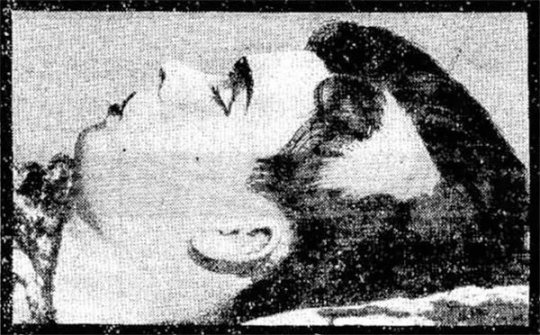
The photograph of the deceased “Roland Owen” that was recognized by his mother, Ruby Ogeltree. Image is public domain.
With this new information the Kansas City Police Department may have hoped for closure in this horrible crime, but there was still no indication as to why this seventeen-year-old was so brutally tortured and amazingly, this identification only raised more questions. According to Mrs. Ogletree, she had received letters from her son after he had already been killed. While the body of Artemus lay in a funeral home she received a typed letter allegedly from him that was postmarked from Chicago, something that surprised his mother not just because of the location but also because as far as she knew her son had no idea how to type. In May of 1935 she received another letter claiming it was from her son, this one saying he was well and heading to Europe. This was followed up by a letter, sent by special delivery and postmarked from New York City, that had Artemus saying that his ship was leaving that very day. Then came the strangest contact of all, a phone call from Memphis, Tennessee from a man claiming that he knew Artemus, that the seventeen-year-old had saved his life in a fight. The caller said he was reaching out to let his mother know that her son was currently living in Egypt with a wealthy woman who he married. According to this man on the phone, the reason Artemus did not write to her was because in the fight where he saved the caller’s life he had had both his thumbs cut off so he was unable to pen a letter. Ruby Ogletree spoke to this man, who she described as speaking “wildly and irrationally” for half an hour before hanging up and reporting him to the police. His name was never revealed and nothing ever came from the strange phone call.
Despite investigations that reached out across multiple states no one was ever arrested for the murder of seventeen-year-old Artemus Ogletree and no theory ever sufficiently panned out to offer up any more information about his tragic end. The Kansas City Police Department kept the case open for decades, routinely going back to the files until the 1950s but with no new evidence coming to light the case went cold.
Despite various theories over the years, the murder of Artemus Ogletree has never been solved. He lays at rest inside Memorial Park Cemetery and Sunset Gardens in Kansas City, Kansas, inside the grave purchased by the unknown caller who wanted him specifically placed there.
#husheduphistory#featuredarticles#KansasCity#Missouri#MissouriHistory#truecrime#truecrimehistory#historiccrime#RolandTOwen#Room1046#HotelPresident#famouscrime#unsolved#mystery#truestory#weirdhistory#strangehistory#scaryhistory#horrorstory#scarystory#creepyhistory#creepystory#whodunnit#unsovedmysteries#kansas#Ogeltree#unknown#historyclass#truth is stranger than fiction#historyisnotboring
5 notes
·
View notes
Text
Little Green Men: The Alien Encounter of Kelly Kentucky
On the night of August 21st 1955 Sheriff Russell Greenwell was working in the police department for the tiny town of Hopkinsville, Kentucky when the night took a sharp turn into bizarre territory. Multiple adults and children stormed into the building highly distressed and saying they needed Greenwell’s help. One of the adults, Billy Ray Taylor, had a racing pulse twice the normal resting rate and the children were completely hysterical. All of them were known in town as very level-headed people. There was no trace of alcohol on anyone and they were a family who took care of themselves, preferring to involve their shotguns rather than the police. What they told Greenwell was that they had spent the last several hours defending their home from attackers, but these attackers were not of this world.
The Sutton Farm was located in nearby Kelly, Kentucky and was the home of Glennie Lankford, her young children Lonnie, Charlton, and Mary, her older sons Elmer "Lucky" Sutton and John Charley "J.C." Sutton, Lucky’s wife Vera, J.C.’s wife Arlene, and Arlene’s brother. Lucky Sutton was home with his family after his last stint with a traveling carnival and his friends Billy Ray Taylor and his wife took the opportunity to stop in and visit everyone. It was a hot Sunday night and at approximately 7pm Billy Ray went to get some water from the well in the backyard when he saw something he could not explain. When he returned to the house he told everyone that he just witnessed a large silver object smoothly traveling through the sky before it went over the house and dropped silently to the ground somewhere in the distance. He was laughed at and the night continued on.

Location of Kelly, Kentucky. Image via wikipedia.org.
The calm did not last long. One hour after Billy Ray’s sighting the Sutton’s dog began to bark incessantly at the back door. When Lucky and Billy Ray went to go see what was going on in the yard they found themselves staring at a glowing light hovering around a three and a half foot tall creature that shimmered like metal with an “oversized head…almost perfectly round, [its] arms extended almost to the ground, [its] hands had talons…and [its oversized] eyes glowed with a yellowish light.”
Frantic and terrified, Billy Ray and Lucky grabbed their shotguns and prepared to fire on the creatures with Glennie and the children watching in bewilderment. Glennie had lived on the property for decades without incident but the commotion coming from the two men concerned her and she sent her younger children to bed before they could get too upset over the outlandish claims coming from Billy Ray and Lucky. Was it a prank? She pressed the two for an explanation but there wasn’t time for any answers. A small glowing figure began to approach the house and for the first time that night shots rang out. The creature raised its arms and did a “flip” before disappearing into the darkness. It was only the beginning of their night.
According to the Sutton family and friends, over the next few hours they found themselves under attack from the little creatures that they could not explain. While hiding inside the home one pressed its face against a window and again flipped out of sight totally unfazed when bullets took out the screen. In a later interview Glennie recalled hiding in a hallway with Billy Ray when they saw one of the beings approaching the back door. She was overcome with shock and fell backwards before her sons carried her into a bedroom. She later stated that “It looked like a five-gallon gasoline can with a head on top and small legs. It was a shimmering bright metal like on my refrigerator.” At one point during the night Billy Ray stepped outside onto a porch where his head was covered by a small overhanging roof. By now the entire family was on alert and they were horrified to see what they described as a claw-like hand reaching down from the roof to grab Billy Ray’s hair from above. The screams cut through the night and Billy Ray was pulled back inside while Lucky ran out and began shooting toward the roof. More than one person reported seeing another small glowing creature jump down and charge into the woods.
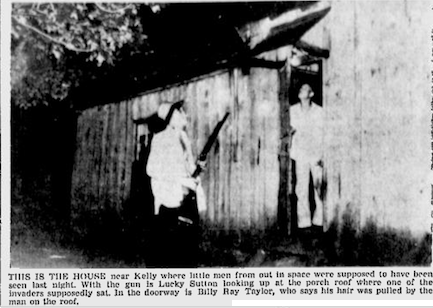
Newspaper article showing the roof where one of the creatures reached for Billy Ray Taylor. Image via https://www.kentuckynewera.com/
For several hours the entire group remained huddled in the house listening to something scratching on the roof and waiting for the unimaginable. Finally, at approximately 11pm they all ran outside, leapt into their cars, and raced to the Hopkinsville police department.
As outlandish as their story sounded, Sheriff Greenwell could not ignore what he was hearing and he decided to go investigate. But, he was not going alone. When the team arrived back at the Sutton farm it included Greenwell, the state police, members of the military police from nearby Fort Campbell, and a photographer from the Kentucky New Era. While searching the premises they found casings from Billy Ray and Lucky’s guns but absolutely no other evidence to suggest anything had happened on the farm that night. Each family member was interviewed individually but all the stories were consistent. With nothing to go on they finally left the site with the family hesitantly returning inside the house. They were not inside long. Before dawn they were all back in their cars, fleeing the house after the creatures came back, appearing in Glennie’s bedroom window and clawing at the screen.
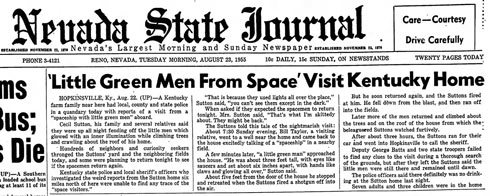
Newspaper article from the Nevada State Journal. Image via Skeptic.com.
When the Suttons returned to their farmhouse they arrived to a chaotic scene. The news of their encounter was spread all over the nation by radio hosts telling their stories and newspapers printing their words alongside shocking illustrations of the “little men” that came out of the sky that night. Curiosity seekers flocked to the farmhouse to investigate the scene for themselves and, in some cases, to take souvenirs. Unfortunately, some also arrived armed with accusations, claiming the family completely fabricated the entire encounter for publicity. The Suttons denied the claims but they did not help their case when they took down their “No Trespassing” signs and replaced them with a price list for admission to the property, information, and photographs. The adult members of the family were again interviewed separately by local radio personality and professional sketch artist Andrew "Bud" Ledwith and every account was the same. They all swore that they were attacked by creatures that stood just under three feet tall, glowed a shimmering metallic green, floated above the ground, and had pointed ears and claws. Tired of being harassed and spied on the family quickly stopped speaking to the media, left the property, and attempted to move on with their lives. Some reports state that after living in the country her entire life Glennie moved into an apartment building to be surrounded by people, she no longer felt safe in isolation.

Illustration of the creatures as described by Billy Ray Taylor. Image via history.com.

Illustration of the creatures as described by Lucky Sutton. Image via history.com.
With no concrete answers as to what haunted the Sutton family and their friends that night the floor was open for theories to fly. Despite Glennie and her sons insisting alcohol was not allowed in the house many said the entire incident was nothing more than a drunken hallucination. Others believed these little silver men were actually a pack of great horned owls which were known to act aggressively toward people. Some even claimed the creatures were monkeys that Lucky and Billy Ray brought home with them from their stint in the carnival.

Great horned owl at night. Image via Youtube.com.
In 1956 ufologist Isabel Davis began an investigation into what became known as the “Kelly–Hopkinsville Encounter”, an investigation that would result in a nearly 200 page report for the Center for UFO Studies. It was far from alone, as the years moved on many other ufologists became fascinated with the event and their varied explanation and opinions did little to pinpoint what happened that August night. The Air Force UFO-investigation program Project Blue Book was aware of the case but no documentation indicates that they officially pursued it. Project Blue Book’s civil investigator (and founder of the Center for UFO Studies) Dr. J. Allen Hynek called the ordeal "preposterous" and offensive to "common sense.” Ufologist Jerome Clark writes about the possible logical explanations, but also admits there was no evidence of a hoax. Some adopted the tale as solid truth, others became staunch supporters of the owl theory, but with every theory and re-visitation the Kelly–Hopkinsville encounter grew in notoriety. With newspapers focusing on the green metallic glow the world was given a term still familiar today, “little green men.”
In 2005 a commemorative event was held to celebrate the fiftieth anniversary of the Kelly-Hopkinsville Encounter and there was a very special guest in attendance. Geraldine Stith, the granddaughter of Glennie Lankford and daughter of Lucky Sutton was there to answer the questions and dispel the rumors. She stated “I thought, I heard it from the horse's mouth, if people want to hear the story, let's get it right.” In 2010 when the town of Kelly was looking for fundraising opportunities they focused on the alleged alien encounter and created an annual event, the Little Green Men Days Festival that still takes place every August. Stith is a guest every year, telling the tale of her family’s terrifying night of the unknown and listening to stories from others. Despite the festive atmosphere structured around the encounter, Stith does not want what her family endured to be lost stating “My family went through something, whether it be paranormal or extraterrestrial, that changed their lives forever. I just want people to realize the terror they went through that night.”

A scene from Little Green Men Days Festival. Image via wkms.org.
Despite countless studies, theories, books, interviews, and experiences, the answer to what haunted the Sutton family and friends that night in August has never been found.
********************
Sources:
“How the 'Little Green Men' Phenomenon Began on a Kentucky Farm” https://www.history.com/news/little-green-men-origins-aliens-hopkinsville-kelly
“The Eerie Story Behind the Small Town Everyone Is Flocking to for the Eclipse This Summer“ https://www.countryliving.com/life/a44064/eclipseville-hopkinsville-ky-history/
“Steven Spielberg, Some Green Men, and Hopkinsville“ https://kyforky.com/blogs/journal/steven-spielberg-some-green-men-and-hopkinsville
“Tales from the path of totality: 62 years ago today, they say, ‘little green men’ invaded this Kentucky farm town” https://www.washingtonpost.com/news/morning-mix/wp/2017/08/21/tales-from-the-path-of-totality-62-years-ago-today-they-say-little-green-men-invaded-this-kentucky-farm-town/
#HushedUpHistory#History#Kentucky#KentuckyHistory#Alienencounter#Unexplained#UnexplainedHistory#Paranormal#ParanormalHistory#ScaryHistory#WeridHistory#ForgottenHistory#StrangeHistory#HorrorHistory#UFO#LittleGreenMen#Truestory#scarystory#truehorror#truthisstrangerthanfiction#unidentified flying object#aliens#alieninvasion#featuredarticles#Unsolved
39 notes
·
View notes
Text
Maynooth’s Demon, Denial, and the Horror of Rhetoric House
In the 1840s much of Ireland was looking to God and begging for answers. Political turmoil and religious conflict collided with the Great Irish Potato Famine bringing immense suffering to the Irish people who seemed to be losing everything and everyone around them. To many young men, the priesthood could promise many positive things during a time of crushing uncertainty like a connection to divinity, the opportunity to help heal the suffering all over the land, and the ability to serve in their spiritual beliefs. For some, it was a way to guarantee a roof over their head and a meal on their plates. Laying just outside of Dublin is Maynooth’s St. Patrick’s College, the training grounds for Ireland’s Roman Catholic priests since 1795. The school was operating less than a century when it was suddenly marked with unexplained horror.

The outside of Rhetoric House at Maynooth (formerly known as Junior House). Image via comeheretome.com.
Not much is known about twenty-one year old Sean O’Grady before his arrival at Maynooth to study the priesthood. He was originally from Limerick and he was a fair student, attending to his studies and boarding in a small room in the residential hall called Junior House (later named Rhetoric House.) Within the first semester things began to change for the young student. The rules for priests-in-training were very strict and his mentors were not pleased to see that O’Grady was letting his studies slip, that he was not attending masses, and that he was increasingly absent for even the most basic requisites. One March morning in 1841 the Dean had had enough of the seemingly lazy student and he made his way up the stairs of Junior House, to Room No. 2, to confront O’Grady. When the door was opened the student was found slumped over on the floor. His sink was full of water, his hand grasped a razor, and the blood that poured from his slit throat was already soaked into the floorboards.
When Thomas McGinn took up residency in Room No. 2 many years later no one told him what history that room held or why it had been left vacant for so long before he was placed there. No one explained the stains on the floor, no one spoke the previous tenant’s name, and McGinn settled in for what he probably expected to be a year of hard study. It is unknown if the Dean or any of the faculty thought of the room’s previous occupant when McGinn began to complain of bad dreams, difficulty focusing, and a general feeling of doom enveloping him. If anyone thought of speaking to McGinn, they were too late. On an April morning in 1860 the quiet landscape of Maynooth was shattered when the student’s body crashed through the window and hit the ground so many floors below with a sickening thud. His bones were broken, he was holding a razor, and he was bleeding. But, he was alive.

A view of St.Patrick’s College, Maynooth. Image via wikipedia.com.
When Vice President of the school Dr. McCarthy visited the shattered man in the infirmary, he received a shocking explanation of what happened. There was nothing accidental about the fall, he threw himself out the window and toward almost certain death. The reason was not suicide, it was fear. McGinn told the Vice President that as he was shaving that morning, razor in hand, he looked up and saw a demonic face behind him urging him to cut his own throat. According to the student he felt a force take his wrist and he knew the only thing to do was escape. But, the only way out was through the window to the ground below. McGinn died of his injuries on April 21st 1860.
The authorities at Maynooth had an urgent decision to make about Room No. 2 of Rhetoric House. The school and church leaders needed to keep the happenings as hidden as possible. The two students were buried in unmarked graves in the on-site cemetery. But were there only two? There are differing accounts with some people claiming there was actually another student, one that took up Room No. 2 in between O’Grady and McGinn who was also found in the room with their throat slashed. There are additional accounts of a priest spending a night in the room after the death of McGinn. He refused to believe all the whispering about the “cursed” room and he wanted to prove once and for all that this was nothing more than a set of tragic and unfortunate coincidences. According to the story, whatever he experienced made him bang on the walls and howl in agony the entire night but left him silent the next morning, refusing to speak of what happened to him in the room of Rhetoric House.
What is known for sure is that on October 23rd 1860 the Trustees decided to convert the room to an Oratory of St. Joseph. The decision was fast and according to the October 24th 1948 issue of Irish Independent, there was no reason given for the conversion. The window that McGinn used to escape evil was walled off, an alter was built, and a statue of St. Joseph was placed. St. Joseph is the patron saint of a peaceful death.
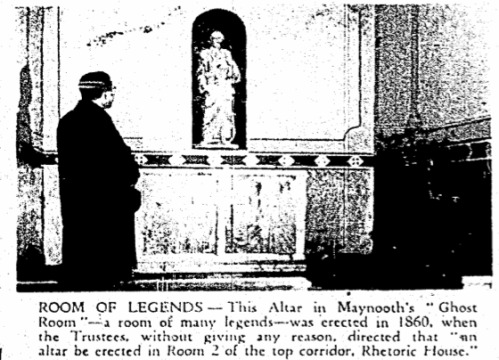
Piece about the Maynooth “Ghost Room” appearing in Irish Independent on October 24th 1948. Image via comeheretome.com.
Room No. 2 of Rhetoric House underwent many changes in the subsequent years, utilized as academic office spaces and a waiting area between offices. Throughout all its incarnations the stories remained and the small room in Rhetoric House began to attract some possibly unwanted attention. In 1998 renowned paranormal researcher, author, and parapsychologist Hans Holzer included the seminary in his book Hans Holzer’s Travel Guide to Haunted Houses and his account of visiting the infamous Room No. 2 with psychic medium Sybil Leek appeared in his book This House is Haunted.
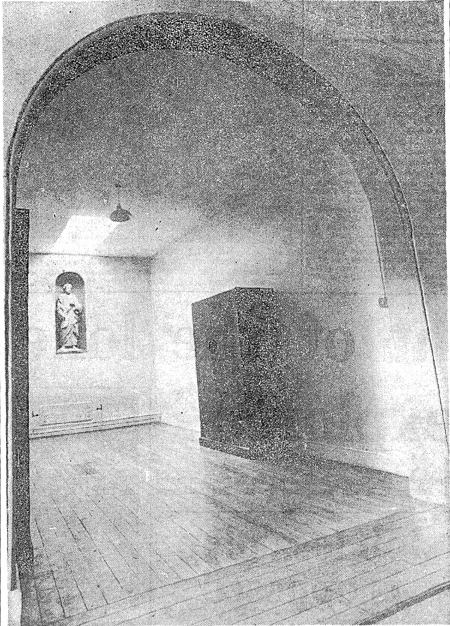
An image of the room as it appeared in 1978 from the Irish Independent June 25th 1978. Image via comeheretome.com.
Today the stories of “The Blood Room” of Maynooth are still spoken, helping the college to earn the dubious distinction of one of the most haunted locations in Ireland. The locations tied to the stories are all still there and out in the open. The stones in the cemetery placed for Sean O’Grady and Thomas McGinn stand without their names and the window where McGinn fell can still be seen from the outside of the building, easily identified as the window that has a blank wall behind its glass. A large bronze plaque names all the deceased buried at Maynooth and among them can be found the names Sean O’Grady and Thomas McGinn. The main goal for visitors though, is to set foot inside Room No. 2 itself. Mostly empty today, the room stand silent with the alter and St. Joseph still watching over the space. Take note though, visitors to the room are forbidden to bring mirrors inside.

The crosses with no names thought to be the final resting places of Sean O’Grady and Thomas McGinn. Image via comeheretome.com.
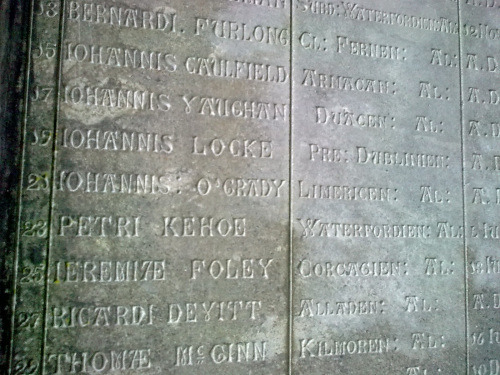
The names of the deceased of Maynooth. Image via comeheretome.com.
On the floor is a large, old, dark stain. Allegedly tested by the school’s Chemistry department and proven to be human blood, the stain is sunken deep into the wooden floorboards, refusing to move after every attempt at removal over the last 160 years.
********************
Sources:
https://comeheretome.com/2012/07/20/the-ghost-room-in-maynooth/
https://soundcloud.com/ghost-maynooth/maynooths-ghost-room
https://www.cultofweird.com/paranormal/maynooth-ghost-room/
#HushedUpHistory#featuredarticles#Ireland#IrishHistory#paranormal#paranormalhistory#Maynooth#unexplained#historicbuildings#historicschool#scarystory#scaryhistory#creepyhistory#forgottnehistory#weirdhistory#horrorhistory#historyisnotboring#demonichistory#unsolved#mystery#coverup#creepy#whathappenedhere#haunted#HauntedIreland#Irishhaunting#terrifyingstory#stillthere#history#historyclass
7 notes
·
View notes
Text
The Groundbreaking Brain of Phineas Gage
Those who knew Phineas well were astonished by his recent behavior. He was rude, outspoken, impatient, and unpredictable, traits that never would have described him only a few years earlier. What should have shocked them more was that he was even still around to exhibit these behaviors. The accident should have killed him in the blink of an eye.
In the fall of 1848 Phineas Gage was twenty-five years old and working as a blasting foreman tasked with preparing a railroad bed near Cavendish, Vermont. Gage had no formal schooling, but he developed an excellent reputation of being a savvy businessman armed with intelligence, precision, and a huge amount of energy. He was described as a very physically fit and healthy young man who almost never succumbed to any form of illness. When Gage went to work on September 13th of that year nothing seemed out of the ordinary despite the work being extremely dangerous. Setting up a bed for the new railroad required a large number of explosives and blasting away rock to make way for the new lines. A large hole was bored into the rock and filled with explosive materials and a fuse. Once the explosives were in place inside the rock the rest of the hole was filled with sand or clay which was then tightly packed in with a long metal rod called a tamping iron in order to ensure the force of the blast was contained inside the rock. At approximately 4:30pm Gage was hard at work when a tamping rod clipped a rock that was armed with an explosive charge. The hit created a spark which ignited the explosives inside sending the metal tamping rod shooting through the air…and straight through Gage’s head.
Dr. Williams heard Gage’s claims that he had been shot through the head with an iron rod but he initially didn’t believe him. He was here, alive, speaking and joking, how could his story possibly be true? But, the horrifying tale was quickly proven accurate to Dr. Williams who recounted:
Gage hit the ground and probably had no idea what just happened to him. The tamping rod was1.25” in diameter, forty-three inches long, weighed thirteen pounds, and sailed clear through his left cheek, through his brain, and out the top of his skull landing eighty feet away from its victim. What was even more shocking than the accident was that Gage was not just alive, he was fully conscious and able to walk himself to an oxcart and request a ride into town to see a doctor. Once arriving at the practice of Dr. Edward H. Williams he even quipped, “Here is business enough for you.”
“I first noticed the wound upon the head before I alighted from my carriage, the pulsations of the brain being very distinct. Mr. Gage, during the time I was examining this wound, was relating the manner in which he was injured to the bystanders. I did not believe Mr. Gage's statement at that time but thought he was deceived. Mr. Gage persisted in saying that the bar went through his head… Mr. G. got up and vomited; the effort of vomiting pressed out about half a teacupful of the brain, which fell upon the floor."
Later that evening the case of Phineas Gage was handed over to Dr. John Martyn Harlow who treated the wounds and continued to observe his new patient. According to Harlow’s later description, Gage remained fully conscious that night, was able to recount what happened, recalled the names of his coworkers, and even said he didn’t need to see any of his friends because he would be back to work in “a day or two.”
Gage may have anticipated bouncing back to work in a matter of days, but his plans were derailed when he developed an infection. Laying in a semi-comatose state, the doctors believed Gage’s luck ran out and this was the long-delayed end of their patient. From September 23rd to October 3rd Gage languished but then he suddenly began to improve. On October 7th he took his first steps out of bed and by the 11th his intellect began to re-emerge. Gage could remember the accident, the day and time it happened, and his coworkers. But, he now had difficulty with other functions like understanding size and calculating sums of money. While there were some obvious changes, most did not question them. After all, the man just survived a metal spike being launched through his head. By the end of the month Gage left medical care and went to his parent’s home in New Hampshire to continue his recovery.
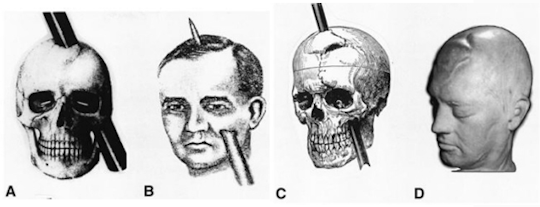
Illustrations of the injuries suffered by Gage.
Gage amazed those around him by continuing to physically heal and improve, but the changes in his personality became more and more concerning. Before the accident the foreman was hard working, intelligent, and highly respected by his employers who considered him “the most efficient and capable foreman in their employ.” However, as time moved on deep transformations revealed themselves. In later observations by Dr. Harlow he noted that Gage:
“Remembers passing and past events correctly, as well before as since the injury. Intellectual manifestations feeble, being exceedingly capricious and childish, but with a will as indomitable as ever; is particularly obstinate; will not yield to restraint when it conflicts with his desires.”
“He is fitful, irreverent, indulging at times in the grossest profanity (which was not previously his custom), manifesting but little deference for his fellows, impatient of restraint or advice when it conflicts with his desires.... A child in his intellectual capacity and manifestations, he has the animal passions of a strong man.”
By the middle of 1849 Gage was eager to get back to work but there was a problem, his personality changes were so severe that his former employers refused to hire him back. They were not the only ones seeing the massive shift in the man. His friends put it bluntly. The man appeared the same, but he was “no longer Gage.”
Unwelcome at his former job Gage was forced to find other ways to support himself and he took on a variety of new professions, one of which was to simply show up. He took work at a livery stable in New Hampshire, but Gage also made appearances throughout New England where he promoted himself and his impossible survival. His most high-profile venue was none other than the Barnum American Museum in New York City. In 1852 Gage was given the opportunity to travel to Chile and work as a stagecoach driver while caring for horses. He remained in Chile until approximately 1859 when his health declined. He left the country and made the journey to San Francisco where his mother and sister relocated to at the same approximate time that he moved to South America. According to his mother, the sight of her son was grim and he was “…in a feeble condition, having failed very much since he left New Hampshire…Had many ill turns while in Valparaiso, especially during the last year, and suffered much from hardship and exposure."
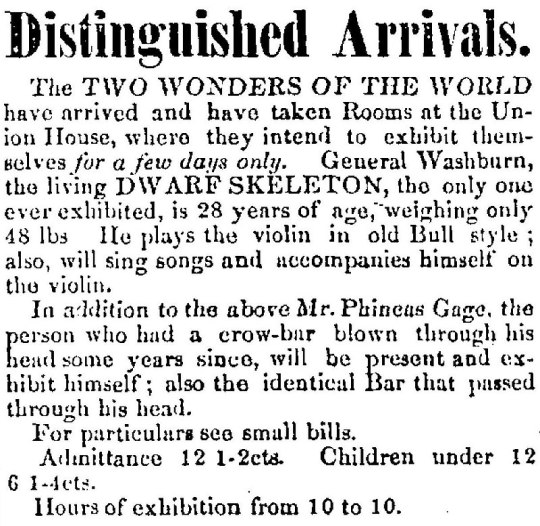
An advertisement for Phineas Gage appearance shortly before his move to Chile.
Once Gage recovered in San Francisco he was again eager to get back to work and he found employment on a farm, but his time there did not last long. In 1860 Gage began having seizures that rapidly grew in severity. On May 16th 1860 Gage went into violent convulsions and never recovered, he died at the age of 36 years old.
Dr. Harlow had not treated Gage for many years but when he heard of his death in California he requested that the family send him his former patient’s skull. They obliged and sent Harlow not only Gage’s skull, but also the thing that made it so desirable. The tamping iron that went through his skull was Gage’s near constant companion for some years, it was even inscribed with its story:
“This is the bar that was shot through the head of Mr Phinehas[sic] P. Gage at Cavendish Vermont Sept 14,[sic] 1848. He fully recovered from the injury & deposited this bar in the Museum of the Medical College of Harvard University.
Phinehas P. Gage • Lebanon Grafton Cy N–H • Jan 6 1850”
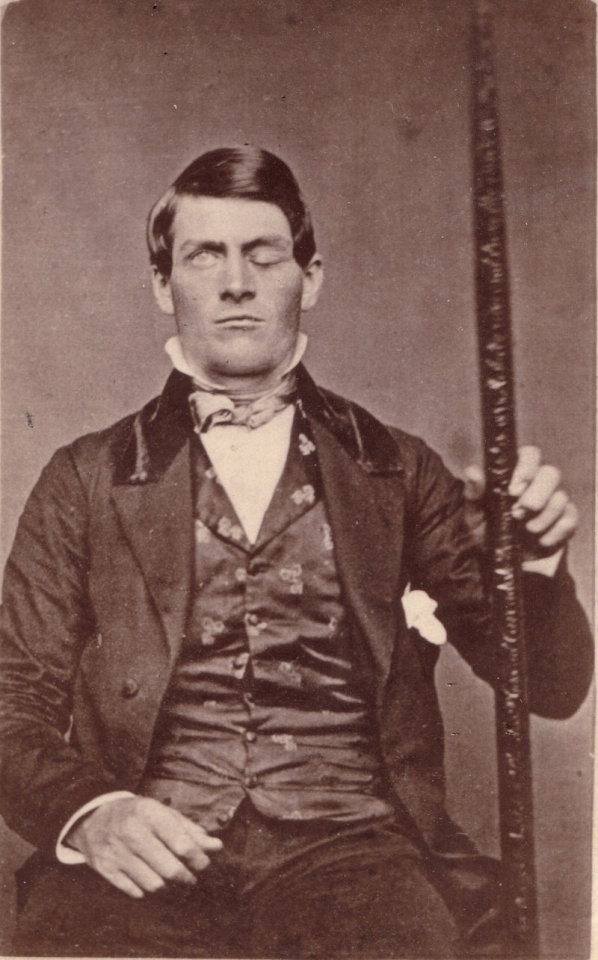
Gage pictured with the tamping rod that went through his head.
After studying the skull and iron Dr. Harlow donated both pieces to Harvard Medical School’s Warren Anatomical Museum where it remains today. The rest of Gage was originally buried in San Francisco’s Lone Mountain Cemetery but in 1940 his remains were moved to Cypress Lawn Memorial Park located in Colma, California.
Throughout his treatment of Gage, Dr. Harlow had suspicions about why his patient’s personality changed so drastically after his accident but the connection between personality and brain injury were still years away from being recognized. It took another decade until the experimental work of David Ferrier came to light describing how damage to the frontal cortex of the brain resulted in “a very decided alteration in the animal’s character and behavior.” Gage, who sustained extreme damage to up to 4% of the cerebral cortex and 1% of the white matter in the frontal lobe, became one of the earliest examples in medical history that the frontal cortex was involved in personality and behavior.
September 13th 1848 was a life changing day for Gage in ways that he never could have expected. It was the day he almost died, the day he became a legend, and a day that changed the early days of neuroscience. To this day the skull of Phineas Gage is still being studied and still giving insight into the connection between brain and behavior, a horrific workplace accident still making medical history 171 years later.
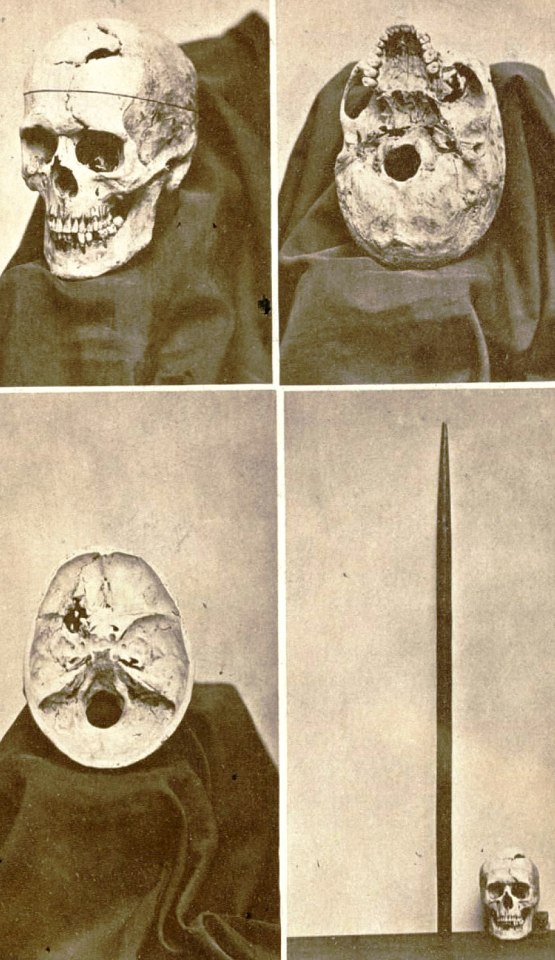
The skull of Phineas Gage and the tamping rod from his accident.
#husheduphistory#featuredarticles#history#gruesomehistory#scaryhistory#forgottenhistory#horrorhistory#weirdhistory#PhineasGage#medicalhistory#medicalmiracle#miraculous#Vermonthistory#railroad#neuroscience#brain#behavior#psychology#accident#horrorstory#truestory#halloween#scarystory#skull#metal#true#story#fact#yikes#terror
9 notes
·
View notes
Text
Long Before Lizzie: The Many Misfortunes of Great-Uncle Borden
The New Bedford Superior Court was buzzing with anticipation. For nearly a year Lizzie Borden sat in a prison cell, accused of murdering both her father Andrew and step-mother Abby and she was finally in court to face the horrific charges against her. The accusation was bad enough, but the method was shocking. Andrew and Abby were hacked to death in their home by an ax, and their daughter was the number one suspect. The evidence against Lizzie was strong. The tension in the house was high and she was known to have a very difficult relationship with her parents, leaving the home after an argument and staying in a rooming house until returning to the Borden home a week before her parent’s deaths. The prosecution claimed that in the weeks leading up to the murders she tried to buy Prussic acid but was unable to secure any. She also burned a dress shortly after the murders claiming she needed to destroy it because it had paint on it. Among everything brought up by the prosecution there was one incident in particular that may have dug up bad memories for anyone familiar with the Borden family.

Illustration of Lizzie Borden during her trial.
Image via By B.W. Clinedinst - https://commons.wikimedia.org/wiki/File:BW_Clinedinst,_the_Borden_murder_trial_cph.3c23237.jpg, CC BY 3.0, https://commons.wikimedia.org/w/index.php?curid=71387462.
Lawdwick Borden was born on March 14th 1812, the son of Martha Patty Bowen and Richard Borden. On September 8th 1833 Borden married twenty-two year old Maria Briggs, but the union was quickly marred by tragedy. By 1836 their two infant children died and two years later they were followed by their mother who passed away in 1838 leaving Lawdwick a widower at twenty-six years of age. On March 16th 1843 he married his second wife, Eliza Darling.

Image showing the home of Lawdwick and Eliza Borden. Image via https://lizziebordenwarpsandwefts.com/
Lawdwick and Eliza lived in a small Cape Cod style home located on land owned by the Borden family in Fall River, Massachusetts. After all of the tragedy in his past, Lawdwick may have had high hopes for his new life with Eliza and on October 22nd 1844 they welcomed a daughter named Maria. Their second daughter, Eliza, arrived in 1846 and she was followed by a son named Holder in 1848. Lawdwick’s first marriage ended in tragedy after five years during which he saw the death of two children and his wife. He had no idea it was about to happen again.
In 1848 Eliza Darling Borden committed the unthinkable. Taking her two year old daughter and infant son into the cellar of her home, she threw the children into a cistern where they both drowned. There are two main variations of where Eliza went next, some say she went upstairs and other say she went behind the chimney in the cellar. Regardless of the exact location, the outcome was the same. Eliza slit her own throat with one of Lawdwick’s straight razors joining her two young children in death at the age of thirty-seven.

The grave of Eliza Borden. Image via findagrave.com.
Lawdwick and Eliza’s youngest daughter Maria survived the ordeal and Lawdwick went on to marry his third wife, Eliza T. Chase on February 29th 1856. Although this third marriage lasted longer than the previous two, in 1865 Lawdwick buried another wife when this Eliza died at fifty-one years old. At this point he had buried three wives and four children all before the age of fifty-three.
Just after little Maria Borden was born in 1844 another house was built on land owned by Lawdwick. Just next door and slightly north of the home where Eliza would eventually take the lives of her two younger children and herself a home was built on 2nd Street for woolen mill carding room supervisor, Charles Trafton and his wife Hannah. By 1851 Charles would lose both his wife to tuberculosis and his infant son Charles Jr. to unknown causes inside the house. Charles and his second wife lived in the home until 1872 when Lawdwick’s nephew and his family moved into it. His nephew was Andrew Borden and he and his wife Abby were killed in Trafton’s house, now the infamous Lizzie Borden house on August 4th 1892. Adding to the bloodshed, after speculating if the two had been poisoned previous to the ax attack their bodies were taken into the dining room of the house, laid out on the dining room table, and their stomachs were cut out for examination.

The Lizzie Borden house in the late 1800s. Image via wikipedia.org.
By the time Lizzie Borden stood in the courtroom accused of murdering her father and step-mother with an ax the name Borden had already had more than it’s fair share of tragedy. During the trial the mental state of the entire Borden family was brought up with a particular focus being put on the suicide of Eliza Borden after drowning her two children. As much as the prosecution wanted to use the tragic deaths as evidence of “inherited madness” it was almost immediately shut down. The defense correctly argued that Eliza was only a Borden by marriage, not by blood. And besides, the surviving child Maria was now forty-nine years old and “alive and well and a mother herself still living in the city.” It was a valuable point to make, and one that may have helped Lizzie walk out of the courtroom as a free woman on June 20th 1893.
When mentioning Fall River, Massachusetts many minds will automatically go to the horrific murders that happened on 2nd Street that hot August morning of 1892. What is discussed far less is that the land where the bloodbath took place was owned by a family member of Lizzie’s that had already seen unspeakable tragedy long before the ax came down on Andrew and Abby. When Lawdwick Borden died on October 6th 1876 he was sixty-two years old and in that time he lost four young children, two of which were murdered by their mother who slit her own throat with one of his razors. Before Andrew and Abby even moved into the house where they would be killed and dissected there were already at least two deaths behind the doors situated on Lawdwick’s land.

The Lizzie Borden house in 2019. Image via wikipedia.org.
The Borden family history was cemented in bloody infamy with Lizzie, but decades before she was born another Borden, her great-uncle Lawdwick, saw horror come to the name through unrepentant death, drownings, disease, and straight razor suicides.
******************************************************************
Sources:
lizziebordenwarpsandwefts.com/
findagrave.com
http://www.murderbygaslight.com/2020/01/
https://www.biography.com/news/lizzie-borden-life-after-murder-trial
https://bostonghosts.com/eliza-borden-and-the-children-in-the-well/
#HushedUpHistory#featured articles#MassachusettsHistory#TrueCrime#LizzieBorden#FallRiver#FamousCrime#FamousMurder#CrimeHistory#truestory#weirdhistory#forgottenhistory#strangehistory#truth is stranger than fiction#historyclass#horrorstory#horrorhistory#scaryhistory#historyisnotboring#cursed#tragictale#darkhistory#scarystory#sadhistory#yikes
1 note
·
View note
Text
Horror-scopes: Arthur Covell and his Savage Stars
The Covell house in Bandon, Oregon was hardly one of peace and harmony. The family consisted of chiropractor Fred Covell, his fourth wife Ebba, his two teenage children from his third marriage, his three young children with Ebba, and his forty-seven-year-old brother Arthur. It was 1923 and the stress level in the house was at new heights. Two of Fred’s children, sixteen-year-old Alton and fourteen-year-old Lucille, were considered mentally disabled and Alton had spent some time in an institution before eventually returning home. His brother Arthur was confined to a bed, paralyzed after being crushed by a truck he was repairing in December 1920.
This situation would be stressful under the best circumstances but adding to the environment was a cloud of sheer contempt that permeated the entire house. Arthur was not an easy person to get along with, regularly fighting with Ebba and referring to his niece and nephew as brats. He rarely left his bedroom, and it was in that space where he brewed and cultivated an all-encompassing obsession with astrology. Within only a few years he successfully turned this obsession into a lucrative source of income, crafting personalized horoscopes and selling them by mail with a client list that included some members of the Hollywood elite.

Arthur Covell, photograph reprinted in New York Daily News, January 25, 1931.
Surrounded by charts, astrological paraphernalia, and endless books filled with scribbled notes and calculations, the image of Arthur Covell with his dark sunken eyes, stringy hair, and waxy complexion was just as endearing as his personality. Ebba reciprocated easily, openly criticizing her brother-in-law right down to complaining about the amount of food he consumed. Given all of this, Fred may not have been surprised when he received a call at his office on the afternoon of September 3rd, 1923. The real surprise came from the voice on the other end, it was Arthur bearing a simple message, “You better get home here fast, the brats tell me there's something wrong with Ebba."
When Fred returned home the scene was horrible and completely mystifying. Ebba was laying dead on her bed with red marks around her nostrils and neck. When he asked his son Alton what happened he only said “Dunno. I found her lying on the floor in the hall by the telephone when I came in from the barn.” His daughter Lucille also claimed no knowledge, asking him repeatedly what was wrong with Ebba. The only person in the house that seemed unsurprised at Ebba’s sudden death was Arthur, who seemed positively delighted. When Fred entered the room to tell him what happened his response was "She's dead, ain't she, Fred? The kids wouldn't tell me. But the stars did. They always tell. Jupiter and Mars are averse to the sun and Venus. That's a juxtaposition Ebba couldn't take."

Ebba Covell, photograph reprinted in the Knoxville Journal, January 18, 1948.
The scene of Ebba’s death was odd. There was no obvious cause of death and despite there being numerous people in the house everyone said they had no idea what could have happened to her. There were many questions, but Fred was not willing to give time for them to be answered. Distant and noncommunicative, he quickly signed his wife’s death certificate citing her demise as “natural causes” and moved to get her into the ground as soon as possible. When the police could not actually confirm Fred’s alibi that he was at work the entire day that Ebba died they put a halt on her burial in order to investigate further.
The attempts to piece together the death of Ebba Covell grew increasingly frustrating with each passing day. The children claimed no knowledge of anything amiss in the house and Arthur only rambled about the death being foretold by the stars in a tone that did not hide his delight in her death. Looking for answers, a second autopsy was done and it revealed that while her neck was dislocated, the injury would not have killed her. Finally, it was determined that the death and the strange burns were caused by a cloth soaked in ammonia being pressed up to her face, eventually suffocating her. Ebba’s death was officially a murder, and the police were certain they knew the killer. In their eyes there was no way for the children Alton and Lucille to plan the complicated killing and they wrote off Arthur due to his being bedridden. Clearly, the murder was committed by Fred Covell. A warrant was issued for his arrest and within hours the children were moved away from the home and both Fred and Arthur were taken to the county jail.

Although officials were certain that they had their culprit securely behind bars there was yet another problem with the case, they did not have the concrete evidence to place the deadly ammonia soaked cloth in Fred’s hand. In search of proof, the Covell’s house was searched. Once inside they found something, but it was not at all what they expected.
At this point it was well known that Arthur Covell was a maniacal astrologer who endlessly ranted about the movement of the stars and how they dictated the paths of the humans below them. When they entered his bedroom and picked up a notebook it seemed at first to be filled with notes of more of the same ramblings, some of which was written in some form of code. But, upon closer inspection the words took a dark turn, talking of various dates and times of death, including that of Ebba Covell. The date was scribbled throughout the book but finally one entry literally spelled it out, “6:20 a.m. Sept 3, Monday. Will Al do his part?" This was followed up with "Sept 3. Eleven a.m. Should have been 11:14.” Ebba’s death was not the only one written out in Covell’s terrifying book. Among the coded messages were mentions of local merchant Ira S. Sidwell who was to "fall down stairs at store. Will have will and other papers in pocket." Then there was a written out tale detailing how the family of local dairy man E.J. Pressy would die in a house fire but "not before you take the doors and windows out of it to be used in my new house." The book detailed the future deaths of twenty-seven prominent citizens of Brandon by every cause imaginable. A discovery of a pile of forged wills with the deceased leaving all of their belongings to Arthur Covell made the astrologer’s book even more sinister. This was not a book of predictions, this was a schedule.

An emaciated Arthur Covell laying on a chair outside the Covell home.
When confronted about his book, Arthur only laughed and said he knew they would find it because the stars said they would. When directly questioned about the dates, times, and methods of death laid out for the citizens of Brandon his response was only “I wished things to happen to people. Got any law against wishing?” It was a painfully frustrating situation. Clearly Arthur had information but the chances of his sharing it were slim to none. But, among his astrological hitlist there was one very important name, Al, the one who he hoped would “do his part” in the murder of Ebba. The police headed off to speak to her sixteen-year-old step-son Alton.
By the time authorities got to Alton, they may have expected just another dead end in the case of Ebba Covell, but this time things went easier than they ever could have expected. Almost immediately Alton began talking, and what he revealed spelled doom not for his father Fred, but for his bedridden uncle Arthur. He told the police that Arthur told him and Lucille to carry out the murder of their step-mother for him, that “Bad things always seemed right when he talked to us. When he said do it we just did anything because it seemed the thing to do.”
His formal statement stated:
“Uncle Arthur told me to buy a 10-cent bottle of ammonia. Then he told me we'd have to kill Ebba because she had learned something he wanted to do and she was going to tell Fred. It was something that would make us all rich and she would spoil his plans. So, she was standing by the telephone when I came in. I put the cloth on her face and held her arms with my left arm around her. It took a long time. I don't know how long. I called Lucille and we got Ebba up on her bed. She was all limp and dead. Lucille threw the bottle down the gully. My uncle told her to. He told us what to say to Dad and the police, so we did. He said he would have a lot more work for me--kidnapping, setting fires, pushing people downstairs. All exciting.”
When confronted about Alton’s confession Lucille immediately confirmed it all. Like her brother, she claimed their uncle had an almost supernatural power over them and they dare not defy him, even when he asked them to kill for him.

Newspaper article showing Alton Covell.
Arthur scowled when he was told about his niece and nephew’s confession. "The brats are telling the truth. I'd have been master of this county after Alton had killed a few good-for-nothings around here if I'd obeyed the stars. Shouldn't ever have worked up Ebba's horoscope on a day when the heavens were unfriendly to me. Made a simple mistake. Figured the wrong day and hour."
The murder trial of Arthur Covell began on November 5, 1924, but there was very little to go over. All three participants in the murder fully admitted their guilt with Lucille giggling through her entire testimony. With little hesitation the jury handed down the verdict of murder in the first degree with a sentence of death by hanging. On May 22, 1925 the killer astrologer was wheeled to the gallows in a wheelchair with his last horoscope, one he wrote for himself, stuffed into the waistband of his pants. In a horrific twist, when Covell’s body dropped his painfully thin frame did not weigh enough to break his neck and end his life. He hung and slowly strangled to death for twenty-six minutes.
Alton and Lucille’s lives took very different paths after their uncle’s trial. Alton was also tried and convicted of murder, but rather than face the gallows he was instead sent to the state penitentiary. Released in 1932, he led a quiet life before passing away in 2002. Lucille was never tried for the crime and disappears from record soon after the trial.
Upon his agonizing death, Arthur Covell was cremated but his ashes were never claimed. To this day all that remains of the killer astrologer sits in storage at the Oregon State Hospital.
#husheduphistory#featuredarticles#history#Oregon#OregonHistory#crimehistory#truecrime#horrorhistory#scaryhistory#darkhistory#weirdhistory#strangehistory#forgottenhistory#astrology#astrologer#astrological#astrologicalhistory#horoscope#horoscopes#murdermystery#scarystory#Horrorstory#truestory#inthestars#truthisstrangerthanfiction#shockingstory#plottwist#historyisnotboring#crazystory#historyiswild
1 note
·
View note